Lewin Benjamin (ed.) Genes IX
Подождите немного. Документ загружается.

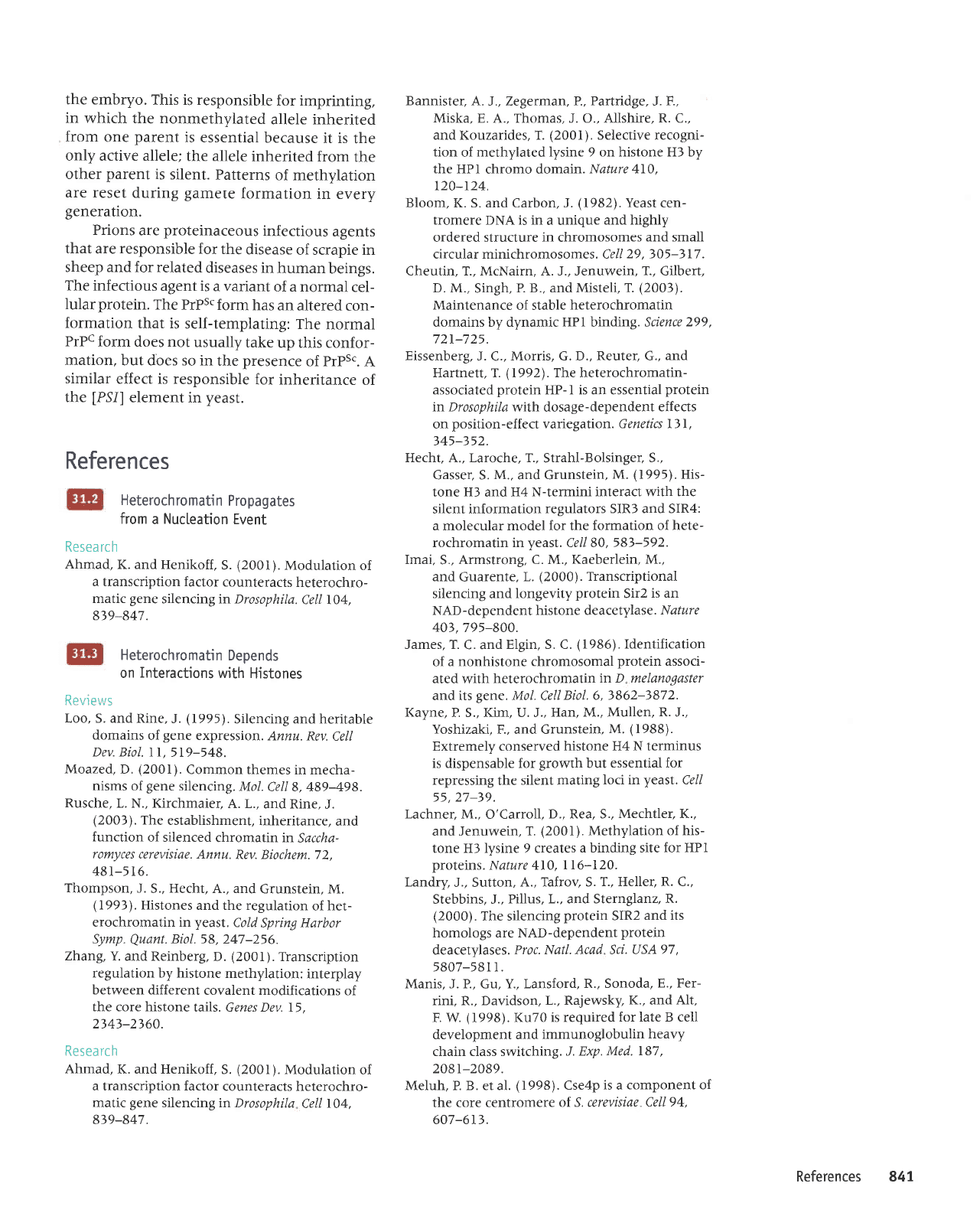
the embryo.
This is responsible
for imprinting,
in
which the nonmethylated
allele inherited
from
one
parent
is
essential
because
it is
the
only active allele;
the allele
inherited
from
the
other
parent
is
silent.
Patterns
of methylation
are reset
during
gamete
formation
in every
generation.
Prions
are
proteinaceous
infectious
agents
that
are
responsible
for
the
disease
of scrapie in
sheep and for related
diseases in
human
beings.
The infectious
agent is
a
variant
of a normal
cel-
Iular
protein.
The
PrPsc form
has
an altered
con-
formation
that is
self-templating:
The
normal
PrPc
form does not
usually
take
up this confor-
mation,
but does so in
the
presence
of PrPsc.
A
similar
effect is responsible
for inheritance
of
the
[PS1]
element in
yeast.
References
Heteroch
romati
n Propa
gates
from
a
Nucleation
Event
Resea rch
Ahmad,
K. and Henikoff,
S.
(2001).
Modulation
of
a transcription factor
counteracts
heterochro-
matic
gene
silencing in Drosophila.
CelI 104,
839-847.
Heterochromatin
Depends
on
Interactions
with
Histones
Reviews
Loo, S. and Rine,
J.
(1995).
Silencing and heritable
domains
of
gene
expression.
Annu. Rev.
Cell
Dev. Biol. I l,
5I9-548.
Moazed,
D.
(2001).
Common themes
in mecha-
nisms
of
gene
silencing.
Mol.
Cell 8, 489-498.
Rusche,
L. N., Kirchmaier,
A. L.,
and Rine,
J.
(2003).
The
establishment,
inheritance,
and
function
of silenced
chromatin in
Saccha-
romyces
cerevisiae. Annu.
Rev. Biochem.72,
48 l-5 I 6.
Thompson, J.
S.,
Hecht,
A., and
Grunstein, M.
(199)1.
Histones
and the regulation
of
het-
erochromatin in
yeast.
Cold
Spring Harbor
Symp.
Quant.
Biol. 58,247-256.
Zhang,
Y. and Reinberg,
D.
(200I).
Transcription
regulation by histone
methylation:
interplay
between different
covalent modifications
of
the core histone
tails. Genes Dev. 15,
2)4)-2j60.
Research
Ahmad,
K. and Henikoff,
S.
(2001).
Modulation
of
a transcription factor
counteracts heterochro-
matic
gene
silencing in Drosophila
Cell
104,
8)9-847,
Bannister, A.
J., Zegerman,
P., Partridge,
J.F.,
Miska, E. A., Thomas, J. O., Allshire,
R.
C.,
and l(ouzarides, T.
(2001
).
Selective recogni-
tion
of
methylated lysine 9 on histone H3 by
the HPI
chromo domain.
Nature 4lO,
t20-r24,
Bloom,
I(. S. and Carbon, J.
(1982).
Yeast
cen-
tromere DNA is in
a unique
and highly
ordered structure in chromosomes
and small
circular minichromosomes. Cell
29, 305-j17.
Cheutin, T., McNairn, A. J., Jenuwein,
T.,
Gilberl.
D. M.,
Singh,
P. B., and Misteli,
T.
(2003).
Maintenance
of stable
heterochromatin
domains by dynamic
HPI
binding. Science
299,
72t-725.
Eissenberg,
J. C.,
Morris, G. D.,
Reuter,
G.,
and
Hartnett, T.
(1992).
The heterochromatin-
associated
protein
HP-l is an essential
protein
in Drosophila
with dosage-dependent
effects
on
position-effect
variegati on. G ene tics l) l,
345-j52.
Hecht, A., Laroche, T.,
Strahl-Bolsinger,
S.,
Gasser, S.
M.,
and Grunstein,
M.
(1995).
His-
tone
H3
and H4 N-termini
interact with the
silent information
regulators SIR3 and SIR4:
a molecular model for the
formation of hete-
rochromatin in
yeast.
Cell 80,
58)-592.
Imai,
S.,
Armstrong, C. M.,
I(aeberlein, M.,
and
Guarente,
L.
(2000).
Tlanscriptional
silencing
and
longevity
protein
Sir2
is an
NAD-dependent histone deacetylase.
Nature
40),795-800.
James, T.
C. and
Elgin, S. C.
(1986).
Identification
of a
nonhistone chromosomal
protein
associ-
ated with
heterochromatin
in D melanogaster
and its
gene.
Mol.
Cell
Biol. 6, )862-3872.
I(ayne,
P. S., I(m, U. J.,
Han, M., Mullen,
R.
J.,
Yoshizaki,
F., and Grunstein,
M.
(1988).
Extremely conserved
histone H4 N terminus
is dispensable for
growth
but
essential for
repressing
the
silent mating
loci in
yeast.
Cel/
55, 27-)9 .
Lachner,
M., O'Carroll,
D., Rea, S.,
Mechtler, K.,
and Jenuwein,
T.
(2001
).
Methylation
of his-
tone H3 lysine 9 creates
a binding site
for HPI
proteins.
Nature 4lO,
l16-120.
Landry,
J., Sutton,
A., Tafrov S.
T., Heller, R. C.,
Stebbins, J.,
Pillus, L., and Sternglanz,
R.
(2000).
The silencing
protein
SIR2
and its
homologs
are NAD-dependent
protein
deacetylases.
Proc. Natl. Acad Sci. USA
97,
5807-58 I l.
Manis, J. P.,
Gu,
Y., Lansford,
R., Sonoda,
E., Fer-
rini, R., Davidson,
L., Rajewsky,
I(.,
and
AIt,
F. W.
(
I998) .
I(u70 is required
for late B cell
development and
immunoglobulin
heavy
chain class switching.
J. Exp.
Med. 187,
208t-2089.
Meluh, P. B. et al.
(1998).
Cse4p
is
a
component of
the core centromere
of. S. cerevisiae Cell
94,
607-6t3.
References 847
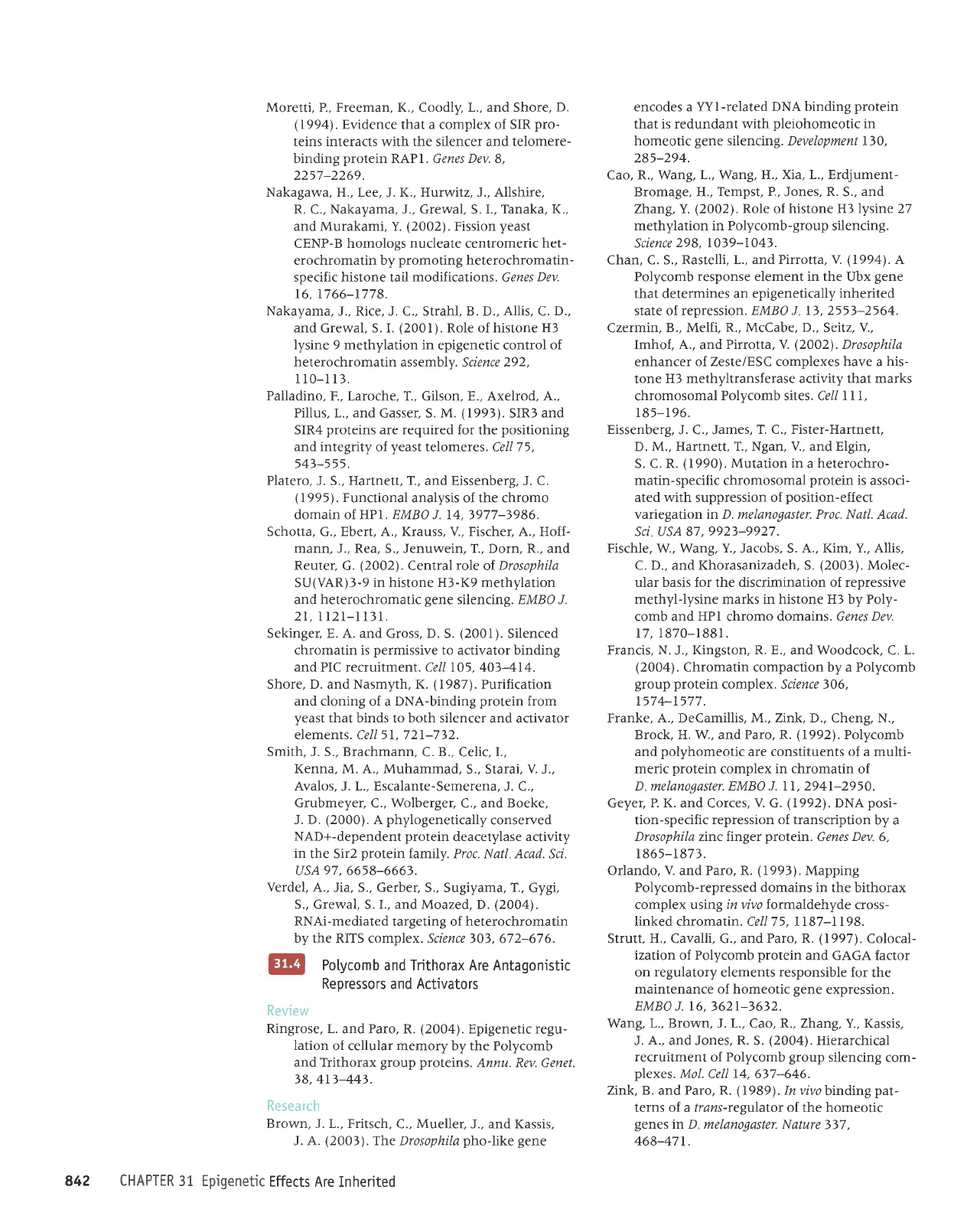
Moretti, P., Freeman, I(.,
Coodly,
L., and Shore,
D.
(19941.
Evidence that a complex of SIR
pro-
teins interacts with the silencer and telomere-
binding
protein
RAPI. Genes Dev. 8,
2257-2269.
Nakagawa, H., Lee,
J.
I(., Hurwitz, J., Allshire,
R.
C., Nakayama, J., Grewal, S.
L, Tanaka, I(.,
and
Murakami, Y.
(2002).
Fission
yeast
CENP-B homologs nucleate centromeric
het-
erochromatin by
promoting
heterochromatin-
specific histone tail modifications. Genes
Dev.
t6,1766-t778.
Nakayama, J., Rice, J. C., Strahl, B. D., Allis, C.
D.,
and Grewal, S. I.
(2001).
Role of histone H3
lysine 9 methylation in
epigenetic control
of
heterochromatin assembly. Science 292,
Il0-113.
Pailadino, F., Laroche, T., Gilson, E., Axelrod, A.,
Pillus, L., and
Gasser, S.
M.
(1993).
SIR3
and
SIR4
proteins
are required for
the
positioning
and integrity
of
yeast
telomeres. Cell
7 5,
54J-555.
Platero,
J. S., Hartnett, T., and Eissenberg, J. C.
(1995
).
Functional
analysis of the chromo
domain of HPl. EMBO J. 14, 3977-)986.
Schotta, G., Ebert, A., I(rauss, V., Fischer, A., Hoff-
mann, J., Rea, S., Jenuwein, T., Dorn, R., and
Re uter,
G.
(2002).
Central
role
ol
Drosophila
SU(VAR)3-9
in histone H3-K9
methylation
and heterochromatic
gene
silencing. EMBO J.
2r, I l2I-l l3I.
Sekinger, E. A. and Gross, D.
S.
(2001).
Silenced
chromatin is
permissive
to activator binding
and PIC recruitment. Cell lO5, 40)-414.
Shore, D. and
Nasmyth,
K.
(1987).
Purification
and cloning
of a
DNA-binding
protein
from
yeast
that binds
to
both
silencer and activator
elements. cell 51, 7 2l-7)2.
Smith, J. S., Brachmann,
C.
B.,
Celic,
I.,
I(enna, M. A., Muhammad,
S., Starai, V. J.,
Avalos,
J.
L., Escalante-Semerena,
J. C.,
Grubmeyer,
C.,
Wolberger,
C., and
Boeke,
J. D.
(2000).
A
phylogenetically
conserved
NAD+-dependent
protein
deacetylase activity
in
the Sir2
protein
family. Proc. Natl Acad. Sci.
usA
97,
6658-666).
Verdel, A., Jia, S., Gerber,
S., Sugiyama,
T.,
Gygi,
S.,
Grewal, S.
I., and Moazed,
D.
(2004).
RNAi-mediated
targeting of heterochromatin
by the RITS complex. Science
)0), 672-676.
Potycomb
and
Trithorax Are Antagonistic
Reoressors and
Activators
Review
Ringrose, L.
and Paro, R.
(2004).
Epigenetic regu-
Iation
of cellular memory by the Polycomb
and Trithorax
group proteins.
Annu. Rev. Genet.
38,4t144j.
Rese a
rc
h
Brown, J. L., Fritsch,
C.,
Mueller,
J., and I(assis,
J. A.
(2003).
The Drosophila
pho-like gene
Effects
Are Inherited
encodes a YYI
-related
DNA binding
protein
that
is redundant with
pleiohomeotic
in
homeotic
gene
silencing. Development 110,
285-294.
Cao, R., Wang, L., Wang,
H., Xia, L., Erdjument-
Bromage, H.,
Tempst, P.,
Jones,
R.
S.,
and
Zhang, Y.
(2002).
Role
of
histone H3 lysine 27
methylation in Polycomb-group silencing.
Science
298, 10)9-1043.
Chan, C. S., Rastelli,
L., and Pirrotta,
V. (1994).
A
Polycomb
response element in the
Ubx
gene
that determines an epigenetically
inherited
state of repression.
EMBO J L),255)-2564.
Czermin,
B., Melfi, R.,
McCabe, D.,
Seitz, V.,
Imhof,
A.,
and
Pirrotta, V.
(2002).
Drosophila
enhancer of ZestelESC complexes
have
a
his-
tone
H3 methyltransferase activity that marks
chromosomal
Polycomb sites. Cell lll,
I
85-l
96.
Eissenberg,
J. C., James,
T. C., Fister-Hartnett,
D. M., Hartnett,
T.,
Ngan,
V.,
and Elgin,
S. C. R.
(1990).
Mutation in
a
heterochro-
matin-specific chromosomal
protein
is associ-
ated
with
suppression oI
position-effect
variegation in D. melanogaster. Proc. Natl. Acad.
Sci USA 87,
9923-9927 .
Fischle, W., Wang,
Y.,
Jacobs, S.
A., I(m, Y., Allis.
C. D., and I(horasanizadeh, S.
(2003).
Molec-
ular basis for the discrimination of repressive
methyl-lysine marks in histone H3 by Poly-
comb and
HPI
chromo
domains.
Genes
Dev.
17,1870-1881.
Francis, N. J.,
ICngston, R. E.,
and Woodcock, C.
L.
(2OO4l.
Chromatin compaction by a Polycomb
group protein
complex. Science 306,
1574-1577.
Franke, A., DeCamillis, M., Zink, D., Cheng,
N.,
Brock, H. W., and Paro, R.
(1992\.
Polycomb
and
polyhomeotic
are constituents of a multi-
meric
protein
complex in chromatin
of
D melanogaster. EMBO J. ll,294l-2950.
Geyer,
P. I(.
and Corces,
V.
G.
(
1992
).
DNA
posi-
tion-specific
repression of transcription
by a
Drosophila zinc finger
protein.
Genes
Dey.6,
t865-t87).
Orlando,
V.
and Paro, R.
(I993).
Mapping
Polycomb-repressed domains in
the bithorax
complex tsing in vivo
formaldehyde
cross-
linked chromain. Cell 7 5, | | 87
-I
19 8.
Strutt,
H.,
Cavalli, G., and
Paro,
R.
(1997\.
Colocal-
ization
of
Polycomb
protein
and GAGA factor
on
regulatory
elements
responsible
for
the
maintenance of homeotic
gene
expression.
EMBO
J.
16,
)62r-1632.
Wang,
L.,
Brown, J.L., Cao, R., Zhang, Y., Kassis,
J.
A.,
and Jones, R. S.
(2004).
Hierarchical
recruitment
of
Polycomb
group
silencing
com-
plexes.
Mol. Cell 14, 6)7-646.
Zink, B.
and
Paro, R.
(1989).
Invivobindingpat-
terns of a trans-rcguIator of the homeotic
genes
in D melanogaster.
Nature 3)7,
468-47 r.
842 CHAPTER
31 Epigenetic
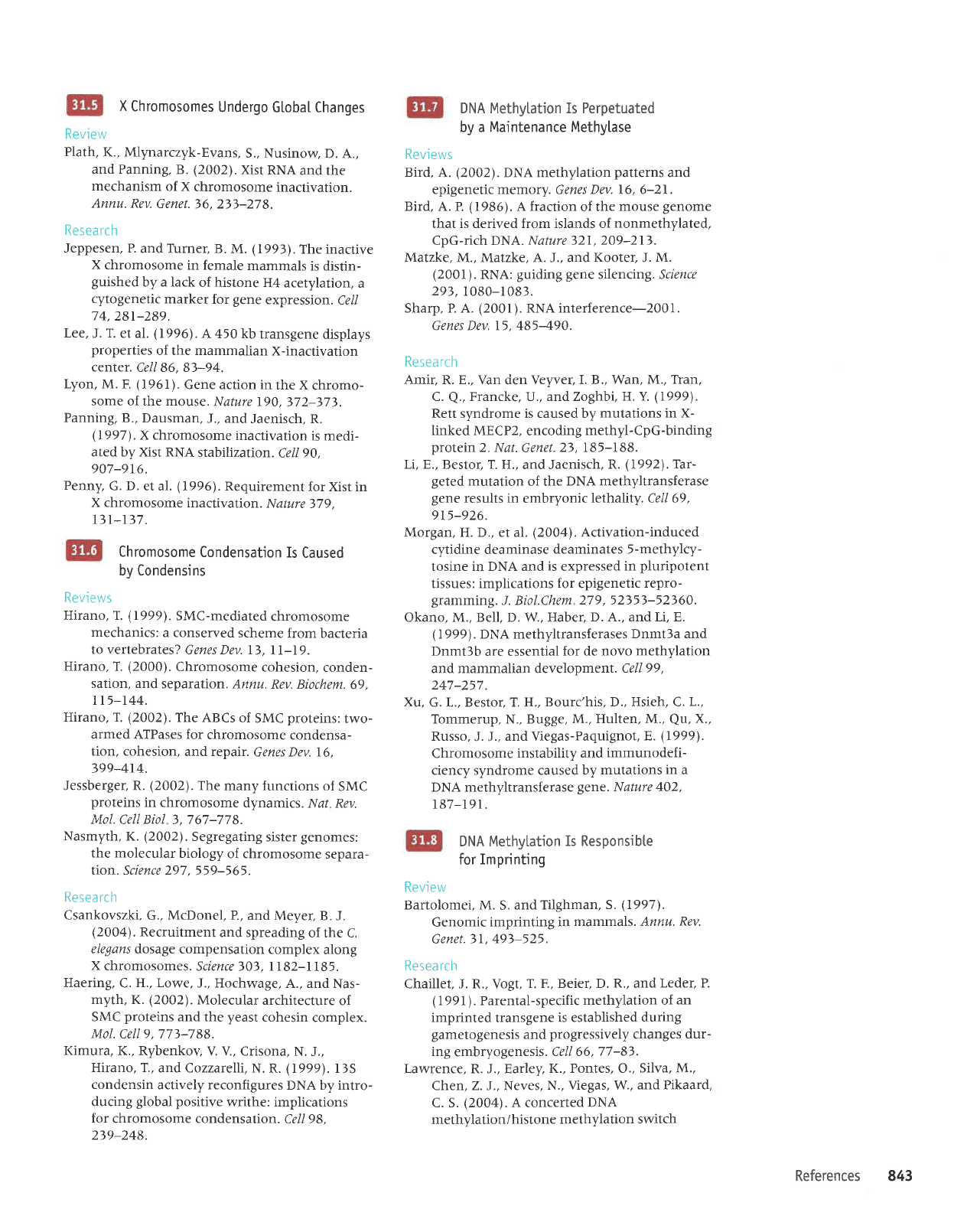
X
Chromosomes
Undergo
GtobaI Changes
DNA Methyl.ation Is Perpetuated
Review
Plath,
I(., Mlynarczyk-Evans,
S., Nusinow,
D. A.,
and Panning,
B.
(2002).
Xisr
RNA
and the
mechanism
of X
chromosome
inactivation.
Annu. Rev.
Genet.
36, 2)3-27
8.
Resea rc h
Jeppesen, P.
and Tlrner, B.
M.
(1991).
The inactive
X chromosome
in female
mammals
is distin-
guished
by a lack
of histone
H4 acetylation,
a
cytogenetic
marker
for
gene
expression.
Cal/
74,28t-289.
Lee,
J.
T.
et al.
(1996).
A 450 kb
transgene
displays
properties
of the mammalian
X-inactivation
center.
Cell 86,83-94.
Lyon, M. F.
(
I 961
)
.
Gene action in
the X
chromo-
some of the mouse.
Nature l9O,372-37).
Panning,
B., Dausman,
J., and
Jaenisch, R.
ll997l.
X chromosome
inactivation
is medi-
ated by Xist RNA
stabilization.
Cell 90,
907-9t6.
Penny,
G.
D.
et al.
(1996).
Requiremenr
for Xist in
X chromosome
inactivation
.
Nature 379,
l)r-r)7.
Chromosome
Condensation
Is
Caused
by Condensins
Reviews
Hirano, T.
(1999).
SMC-mediated
chromosome
mechanics:
a conserved
scheme
from bacteria
to vertebrates?
Genes Dey.13,
I l-19.
Hirano, T.
(2000).
Chromosome
cohesion,
conden-
sation, and
separation. Annu.
Rev. Biochem.
69,
tt5-t44.
Hirano, T.
(2002).
The ABCs
of
SMC
proreins:
two-
armed ATPases for
chromosome
condensa-
tion, cohesion,
and repair.
Genes Dev. 16,
399-414.
Jessberger, R.
(2002).
The
many functions
of
SMC
proteins
in chromosome
dynamics.
Nat Rev.
Mol.
Cell
Biol
),767-778.
Nasmyth, K.
(2002).
Segregating
sister
genomes:
the molecular
biology
of chromosome
separa-
tion. Science 297,
559-565.
Resea rch
Csankovszki, G., McDonel,
P., and Meyer,
B. J.
(2004).
Recruitment
and spreading
of the C.
elegans dosage compensation
complex
along
X chromosomes.
Science 303, I182-l185.
Haering,
C.
H., Lowe,
J., Hochwage,
A., and
Nas-
myth, K.
(2002).
Molecular
architecture
of
SMC
proteins
and
the
yeast
cohesin
complex.
Mol.
Cell
9,773-788.
I(imura,
I(., Rybenkov
V.
V.,
Crisona,
N. J.,
Hirano, T.,
and Cozzarelli,
N. R.
(1999).
llS
condensin
actively reconfigures
DNA by intro-
ducing
global positive
writhe: implications
for
chromosome condensation.
Cell 98.
219-248.
by a Maintenance Methy[ase
Reviews
Bird,
A.
(2002).
DNA methylation
patterns
and
epigenetic memory. Genes Dev. 16, 6-21 .
Bird, A. P.
(1986).
A
fraction
of the
mouse
genome
that is derived from islands of
nonmethylated,
CpG-rich DNA. Nature )21,209-213.
Matzke,
M., Matzke, A. J., and
Kooter,
J.
M.
(2001).
RNA:
guiding
gene
silencing. Science
293,1080-1083.
Sharp, P. A.
(2001).
RNA interference-2OO1.
Genes Dev. 15, 485-490.
Resea rc
h
Amir, R. E., Van
den
Veyver, I. B., Wan,
M., Tran,
C.
Q.,
Francke, U., and Zoghbi,
H. Y.
(I999).
Rett syndrome is caused by
mutations in X-
linked MECP2,
encoding
methyl-CpG-binding
protein
2.
Nat. Genet.23,
185-188.
Li, E., Bestor,
T. H., and Jaenisch,
R.
(1992).
Tar-
geted
mutation
of the
DNA methyltransferase
gene
results in embryonic
lethality. Cell 69,
9t5-926.
Morgan, H. D., et al.
(2004). Activation-induced
cytidine deaminase
deaminates 5-methylcy-
tosine in DNA and
is
expressed
in
pluripotent
tissues: implications
for
epigenetic
repro-
gramming.
J. Biol.Chem
279, 52)5)-52)60.
Okano, M., Bell, D. W., Haber,
D. A., and Li, E.
(\999)
. DNA methyltransferases
Dnmt3a and
Dnmt3b
are essential
for de novo
methylation
and mammalian development.
Cell 99,
247-257.
Xu,
G. L., Bestor, T. H.,
Bourc'his, D., Hsieh, C.
L..
Tommerup,
N.,
Bugge,
M., Hulten, M.,
Qu,
X.,
Russo,
J. J.,
and Viegas-Paquignot,
E.
(1999\.
Chromosome
instability and
immunodefi-
ciency syndrome caused by
mutations
in
a
DNA methyltransferase
gene.
Nature 402,
187-191.
DNA Methytation
Is Responsibte
for Imprinting
Review
Bartolomei, M.
S.
and Tilghman,
S.
(1997).
Genomic
imprinting in
mammals. Annu.
Rev.
Genet.
31, 49j-525 .
Resea rc h
Chaillet, J. R., Vogt,
T. F., Beier, D. R., and
Leder, P.
(
1991
)
. Parental-specific
methylation of
an
imprinted
transgene
is established
during
gametogenesis
and
progressively
changes
dur-
ing
embryogenesis.
Cell 66,77-8).
Lawrence, R. J., Earley,
K., Pontes, O.,
Silva, M.,
Chen, Z. J., Neves, N.,
Viegas, W,
and Pikaard,
C. S.
(2004).
A concerted
DNA
methylation/histone
methylation
switch
References 843
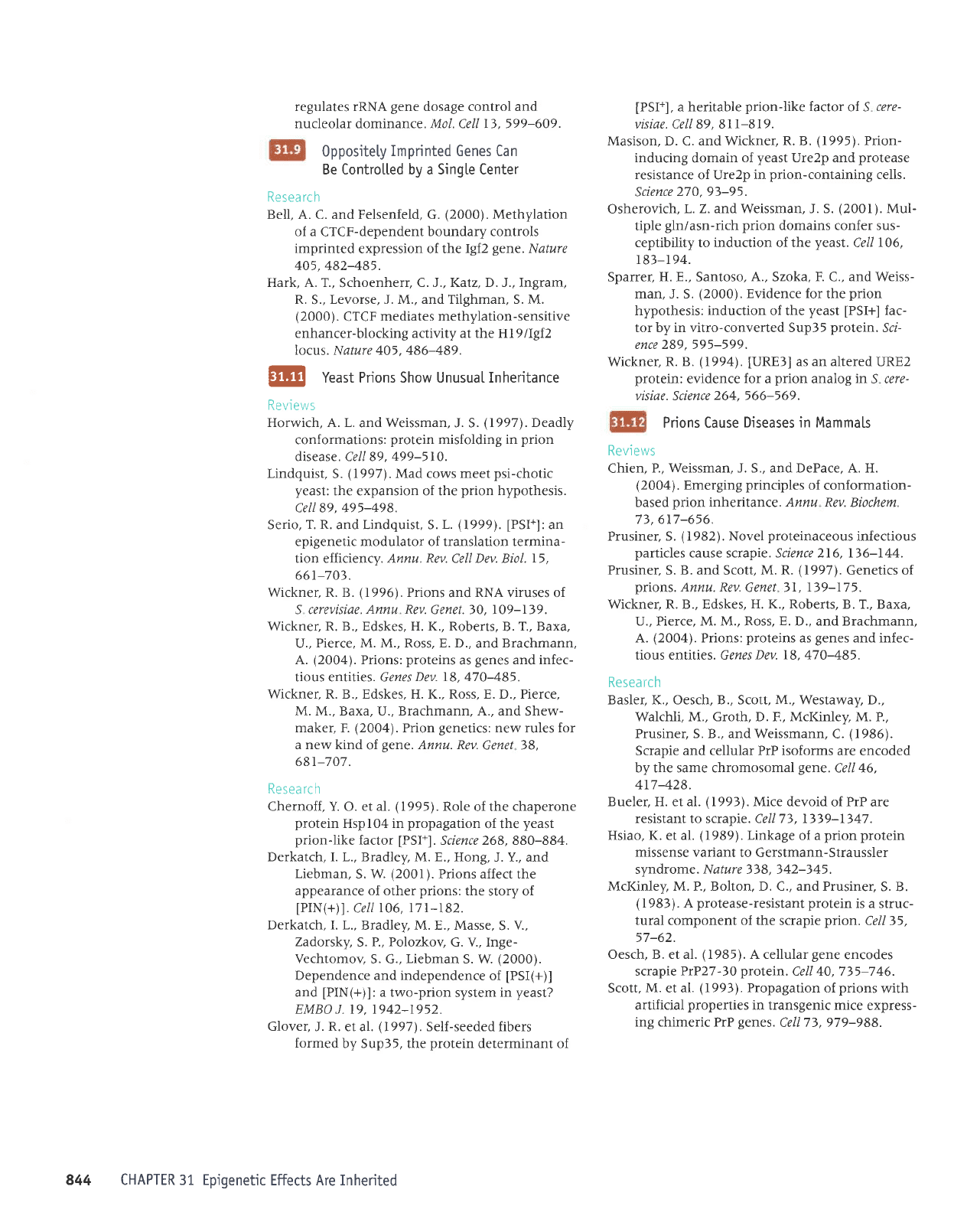
regulates rRNA
gene
dosage control and
nucleolar dominance. Mol. Cell l),599-609.
0ppositety
Imprinted Genes Can
Be Controtted by a Sing[e Center
Resea
rch
Bell, A. C. and Felsenfeld, G.
(2000).
Methylation
of a
CTCF-dependent
boundary controls
imprinted
expression of the
Igf2
gene.
Nature
405,482485.
Hark, A. T.,
Schoenhen,
C. J.,Katz,D. J., Ingram,
R.
S.,
Levorse, J. M., and Tilghman, S. M.
(2000).
CTCF
mediates methylation-sensitive
enhancer-blocking activity at the Hl9/Igf2
locus.
Nature
405, 486-489.
@
Yeast Prions Show UnusuaI Inheritance
Reviews
Horwich, A. L.
and
Weissman,
J. S.
(1997).
Deadly
conformations:
protein
misfolding in
prion
disease. Cell 89,
499-510.
Lindquist,
S.
(1997).
Mad cows me et
psi-chotic
yeast:
the expansion of the
prion
hypothesis.
Cell 89, 495-498.
Serio,
T. R.
and Lindquist, S.
L.
(1999).
[PSI+]:
an
epigenetic modulator of translation termina-
tion efficiency. Annu.
Rey.
Cell Dev. Biol.
15,
661-703.
Wickner, R. B.
(t
996). Prions
and
RNA
viruses of
S cerevisiae.
Annu Rev.
Genet. 30, l]9-1i9.
Wickner, R. B., Edskes, H. K., Roberts,
B.
T., Baxa,
U.,
Pierce, M. M., Ross, E. D.,
and
Brachmann,
A.
(2004).
Prions:
proteins
as
genes
and infec-
tious entities. Genes
Dev. 18, 470-485.
Wickner, R. B., Edskes, H. I(., Ross, E. D., Pierce,
M. M., Baxa, U., Brachmann, A., and Shew-
maker, F.
(2004).
Prion
genetics:
new rules for
a new kind
of
gene.
Annu. Rev.
Genet )8,
68t-707.
Resea rc h
Chernoff, Y. O. et al.
(1995).
Role
of the
chaperone
protein
Hspl04 in
propagation
of the
yeast
prion-like
factor
[PSI+].
Science 268, 880-884.
Derkatch, I. L., Bradley, M.
E., Hong, J. Y., and
Liebman,
S. W'
(2001).
Prions affect the
appearance of other
prions:
the
story of
IPIN(+)1.
Cell
106, 17r-182.
Derkatch, I. L.,
Bradley, M. E., Masse,
S.
V.,
Zadorsky,
S.
P., Polozkov,
G. V., Inge-
Vechtomov
S. G.,
Liebman
S. W.
(2000).
Dependence and independence
of
[PSI(+)]
and
[PIN(+)]:
a two-prion
system
in
yeast?
EMBO
J.
t9,1942-1952.
Glover,
J.
R.
et al.
(19971.
Self-seeded fibers
formed
by Sup35, the
protein
determinant of
[PSI+],
a heritable
prion-like
factor
of S
cere-
visiae. Cell 89, 8l
l-819.
Masison, D. C. and Wickner,
R.
B.
(1995).
Prion-
inducing
domain
of
yeast
Ure2p and
protease
resistance
of Ure2p
in
prion-containing
cells.
Science
270, 93-9r.
Osherovich,
L. Z. and Weissman, J. S.
(2001).
Mul-
tiple
gln/asn-rich
prion
domains confer sus-
ceptibility to induction of the
yeast.
Cell
106,
t83-t94.
Sparrer, H. E., Santoso,
A.,
Szoka,
F.
C.,
and
Weiss-
man, J. S.
(2000).
Evidence for
the
prion
hypothesis:
induction
of the
yeast
[PSI+]
fac-
tor by in vitro-converted Sup35
protein.
Scr-
ence 289, 595-599.
Wickner,
R. B.
(1994).
IURE3]
as an altered
URE2
protein:
evidence
for
a
prion
analog
in
S cere-
visiae. Science
264, 566-569.
Prions Cause
Diseases in Mamma[s
Reviews
Chien,
P.,
Weissman,
J. S., and DePace, A. H.
(20041.
Emerging
principles
of conformation-
based
prion
inheritance. Annu Rev.
Biochem.
73,617-656.
Prusiner, S.
(1982).
Novel
proteinaceous
infectious
particles
cause scrapie. Science 216, 136-144.
Prusiner,
S.
B. and
Scott,
M. R.
(1997).
Genetics of
prions.
Annu. Rev.
Genet 31,139-175.
Wickner, R. B., Edskes,
H. I(., Roberts,
B. T., Baxa,
U., Pierce, M. M., Ross,
E.
D., and Brachmann,
A.
(2004).
Prions:
proteins
as
genes
and infec-
tious entities. Genes
Dev. 18.
470-485.
Resea rch
Basler, I(., Oesch, B., Scott,
M.,
Westaway, D.,
Walchli, M., Groth, D. F., MclCnley, M. P..
Prusiner, S. B., and Weissmann,
C.
(1986).
Scrapie
and cellular PrP isoforms
are encoded
by the same chromosomal
gene.
Cell 46,
4t7-428.
Bueler, H. et al.
(1993\
. Mice devoid
of
PrP
are
resistant to scrapie. Cell73, 13)9-1347.
Hsiao,
K.
et al.
(
1989)
.
Linkage
of a
prion protein
missense
variant to Gerstmann-Straussler
syndrome. Nature
j38,
J42-345.
MclCnley, M. P., Bolton, D. C., and Prusiner,
S. B.
(
1983). A
protease-resistant protein
is a struc-
tural component of the scrapie
prion.
Cell 35,
57-62.
Oesch, B. et al.
(1985).
A cellular
gene
encodes
scrapie
PrP27-30
protein.
Cell 40,7)5-746.
Scott,
M.
et al.
(1993).
Propagation
of
prions
with
artificial
properties
in transgenic mice
express-
ing chimeric PrP
genes.
CellT),979-988.
844
CHAPTER 31 Epigenetic
Effects Are Inherited
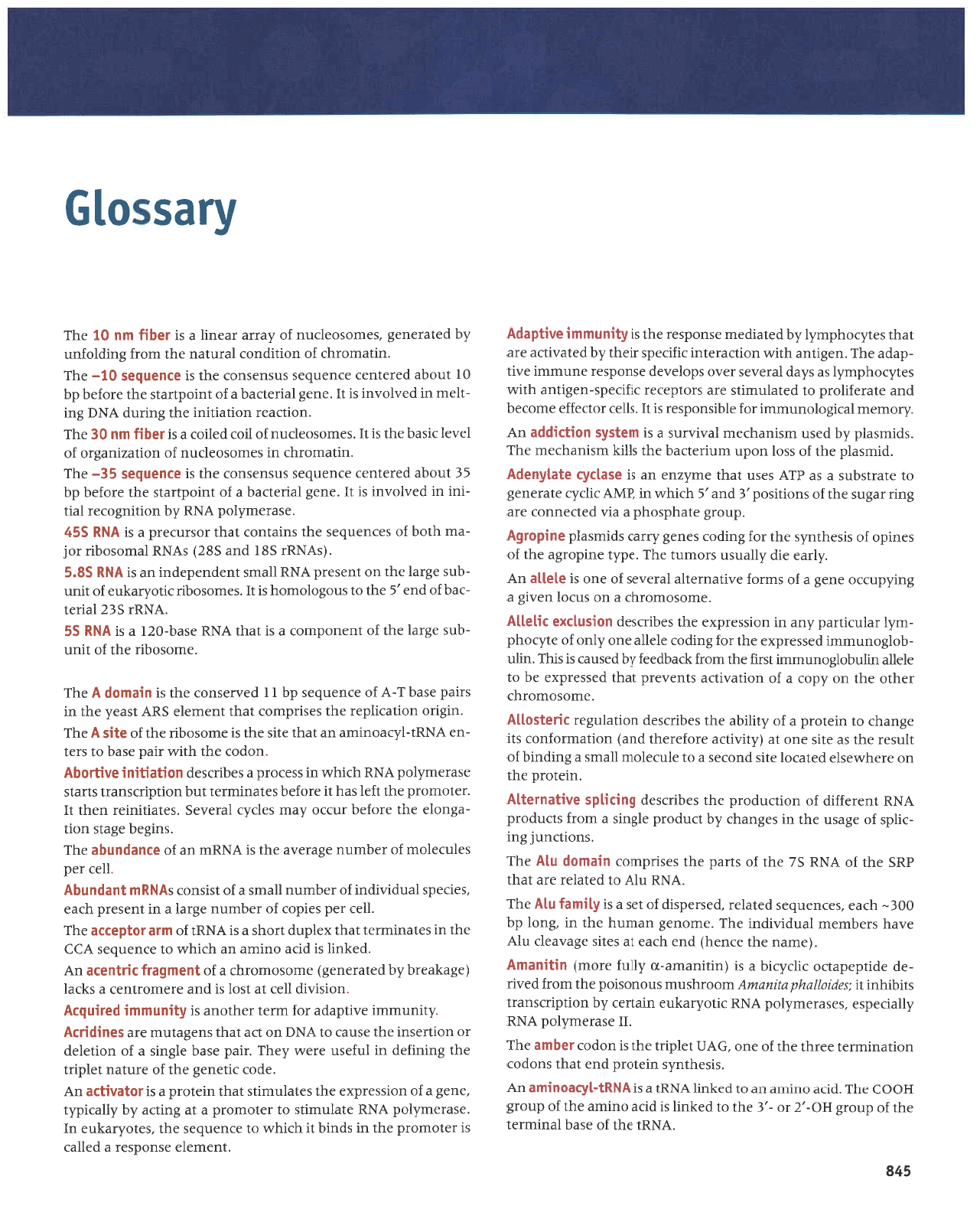
9re
'YNul
eql
Jo
asPq
Ieururrel
aqt
Jo
dnoJS
ltirO-,2
to
-,€
eLIt
ol
pa>lur
sr
prJE
ourue
aql
;o
dnorE
HOO)
eql'prrp ourrue
ue ot
pe>lurT
VNUI
e sr
y11X11/[reoullup
uV
'srsaqlu^s
ureloJct
pua
lpql
suopo)
uorteurruJet
aerql aql
Jo
euo
'gvn
]a1drr1
aqt
sr uopoJ
taque
JqI
'11
aserau.ri.lod
VllU
,{11enadsa'saseraru,{.1od
vNU
rltozhe>lno
urpua) z{q
uorldr,rrsuerl
stlq1qul
1l
lsapto11a4d
altuau,rv
rnoorrlsnru
snouosrod aqt ruor; panrr
-ap
aprldadelro
rlpzbrq
e sr
(urlrueure-n
,{1n; aroru)
uqlueuy
'(aueu
aqr aruaq) pua
qtpe
lp
salrs a8eneap
n1y
anpq sreqruaru
Ienpr^rpur
aql
'eruoua8
uerunq
aqr u1
'3uo1
dq
00€-
qJpa
'saruanbes
peleler
'pasradsrp
Jo
tes
e sr
/[11ure;
nlv
eqJ
'YNU
nlv
01
palPlar
JrP
]Pq]
dUS
aqt
Io
vNU S/
aql;o sged
aqt sasrrduror
ulpluop
nlv
eqJ
'suorpun[
3ur
-rqds
;o
a8esn
aql ur sa8ueqt
.{q
nnpord
alEurs e ruory
strnpord
VNU
luara;Jrp
Jo
uort)npord
aqr
saqrrrsap
6upgds e1lleu;ellv
'uraloJo
aql
uo ereqMesla palpJol
atrs puoJes
e ol
alnJelou
Ilprus
E Surpurq;o
tlnser
eql se alls auo
re
(,{rprlpe
aroJareqt pue)
uorleruroJuoJ
str
a8ueqr
ot uralord e;o ,llgrqe
aqt
saqTJJSap uorlelnEar
lyapollv
'eIuosoruoJqJ
Jaqlo aql uo,{dor
p
Jo
uorte^llrB
sluaaard
teql
passardxa
aq ol
a1a1p ulpqopounurur
tsJrJ
aql ruorJ
)ppqpaa;.dq pasnet
fl srqJ
'ul1n
-qolEoununur
passardxa
aqt ro; SurpoJ
alelle auo,{.1uo;o
ar[roqd
-ru.{.1
relnrrlred,{ue
ur uorssa-rdxa
aql saqrrJsap
uoJsnllxe lgallv
'eurosoruoJq)
P uo
snJol uaar8 e
Suddnrro
aua8 B
Jo
sruroJ
e^rlpurallp
lpreles
Jo
auo sr
alolle
uV
',{pea
arp dllensn
sJorunl aq1
'adfu
aurdor8e aqt
yo
saurdo
yo
srsaqlu,{s aql
JoJ Surpor
saua8,{.rrBr spnuseld
auldot6v
'dnor8
aleqdsoqd
p
erl
palJauuoJ
ere
Surr re8ns aql
Jo
suorlrsod,g pue,E
qJIqM
ur
firyy
rqrdr
aleraua8
ot elprtsqns
e sp
dIV
sesn
tpqt
aru,{.zua ue
sr
aselt/[r elelfuepv
'pruseld
eq1
Jo
ssol
uodn runrralreq
eqt sllr>l tusrueq)eu eqJ
'spnuseld
,{q pasn
usrueq)eur
IeArAJns
e sr
uals/ls uolplppe
uV
'zlroruaru
lerrSolounrurur
ro; alqrsuodsaJ
sl
1I's11a)
rot]eJJe
euoJaq
pue
aleralllord o1
palelmurts
are srotdarar
rryoads-ua8rlue
q1r.tr
sa/.roqdruLl se
slep
IpJaAas
razro
sdolanap asuodsar
Junrutur alrl
-depe
aql
'ua8rlue
qlru
uorlJpralur rr;oads
4aqr.{q
palelrDp
are
leqr
sa{roqdu.{1 ,{q pereparu
asuodsar
aqt sr,l$1unuu!
an$dppv
'tueruela
asuodsar e
peller
sr raloruord aqt
ur spurq
ll
qJTqlnr ol aruanbas aql
'salo,{re>1na
u1
'aseraru.,i.1od
VNU
aleFrurls
ol ralourord e
1B
Euure
z(q [1ertdd1
'aua8
e;o uorssardxa
aq1 salplnurts
teql
uralord e st
lolenqre
uy
'apor
rrlaua8
aql
;o
arnleu
1a1drr1
aqt Eurur;ap
ur
InJasn
era,n,{aq1
'rred
aseq al8uts e
Jo
uouelap
ro uoluesul
eqt esnpJ 01
VN61
uo
De teql
sua8elnru eJe
seuJpFlV
',hlunruurr
a.lrldepe ro; ruJet
raqloue st
fi1unuu1
parlnblv
'uorsr^rp
IIeJ
le lsol
sr
puP
areruoJlual e s>IJel
(a8e>1earq,{q palerauaE) aruosoruorqr e;o
lueu6er}
lFlua)p
uV
'pa{u{
sr
prf,e
ourrue
ue
qrrqM
o1 aruenbas
y33
eql ur seleurural
1eq1
xaldnp
uoqs
e sI
VNul
Io
uup roldellp
aq1
'1ar
rad sardor;o
raqunu a8rel e ut
luasard
qrea
'saoads
pnphrpur
Jo
requnu
ilerus
e
Jo
lsrsuor
sVNUtu
luepunqv
'11ar
rad
seln)aloru
Jo
raqurnu a8prane eql
sr
VNUUr
ue
Jo
atuepunqe
aq1,
'sur8aq
a8els uorl
-eEuola
eql
eroJaq rnrro zleur sapdr
lera,ras
'selpllluler
ueqr
tI
'raloruord
aql
Ual
seq
tr
eroJaq saleulluJel
lnq
uorldlnsueJl suels
aseraru,{1od
yNU
qrlqM
ur ssarord
p
saqrrJsap
uogeglut ol11.toqv
'uopoJ
eql
qlIM rted aseq 01 srel
-ua
ypgr-lubeoururp
up
lpqt
atrs aq1 sl eruosoqlr
aqt
Jo
alJs
V
aqJ
'ur8rro
uorlerlldar
aql sasrrdruoJ
leql
tueuala
SUv
lspe^
eql uI
srred aseq
I-v
Jo
aruanbas
dq
11
pa,rrasuo)
aqt
q
uleuop
V
aq1,
'euosoqrr
aql
Jo
lrun
-qns
a8rel eql
Jo
tuauoduror
e sI
rpql
vNU
aseq-g7I P sl
VNU
Sg
'YNUr
S€Z
Prral
-JeqJo
pua
/E
aql o1
snoSoloruoq sI
lI'saurosoqg
rpofuelne
Jo
llun
-qns
a8rel
eqt uo
tuasard
ypg
llptus
tuapuadaput
ue sl
VNU
S8'g
'(sVNUr
58I
pup
S8Z)
sVNU
leruosoqtr
rof
-pru
qloq;o saruanbas eqt
sulpluoJ
lpql
Josrn)ard
e st
ypg
597
'aseraurdlod
VNU
^q uotltuSorar
1et1
-rur
ur
pa^lo^ur sf
lI
'aua8
lerralreq
e
;o
lurodupls
eq1 aro;aq dq
E€
tnoqe
paJetue) aruanbas snsuesuo)
aql sl
atuanbas
g€-
aqJ,
'urlpruoJq)
uI
saurosoelJnu
Jo
uollPzlue8ro
;o
Ie^al
)rseq aql
sl
1I
'seuosoalJnu
Jo Io)
palroJ P sI
req!+ uu
0€
aqJ,
'uolDear
uoltplllul aqt
Sutrnp
vNC
8ul
-tleu
ur
pa^lolur sl
u
'aua8
lerJeDeq
e;o
turodlrels
aql aroyaq dq
0I
tnoqp
paralue) aruanbas snsuesuoJ
aqt sr
eluenbes
oI-
eql
'urteuorqJ
Jo
uolllpuoJ
Iernlpu
eql
luorJ 8utp1o;un
,{q
pateraua8
'sauosoal)nu;o
,{erre rpeuq
P sl
laqg uu
Otr
eqJ
fues
olg
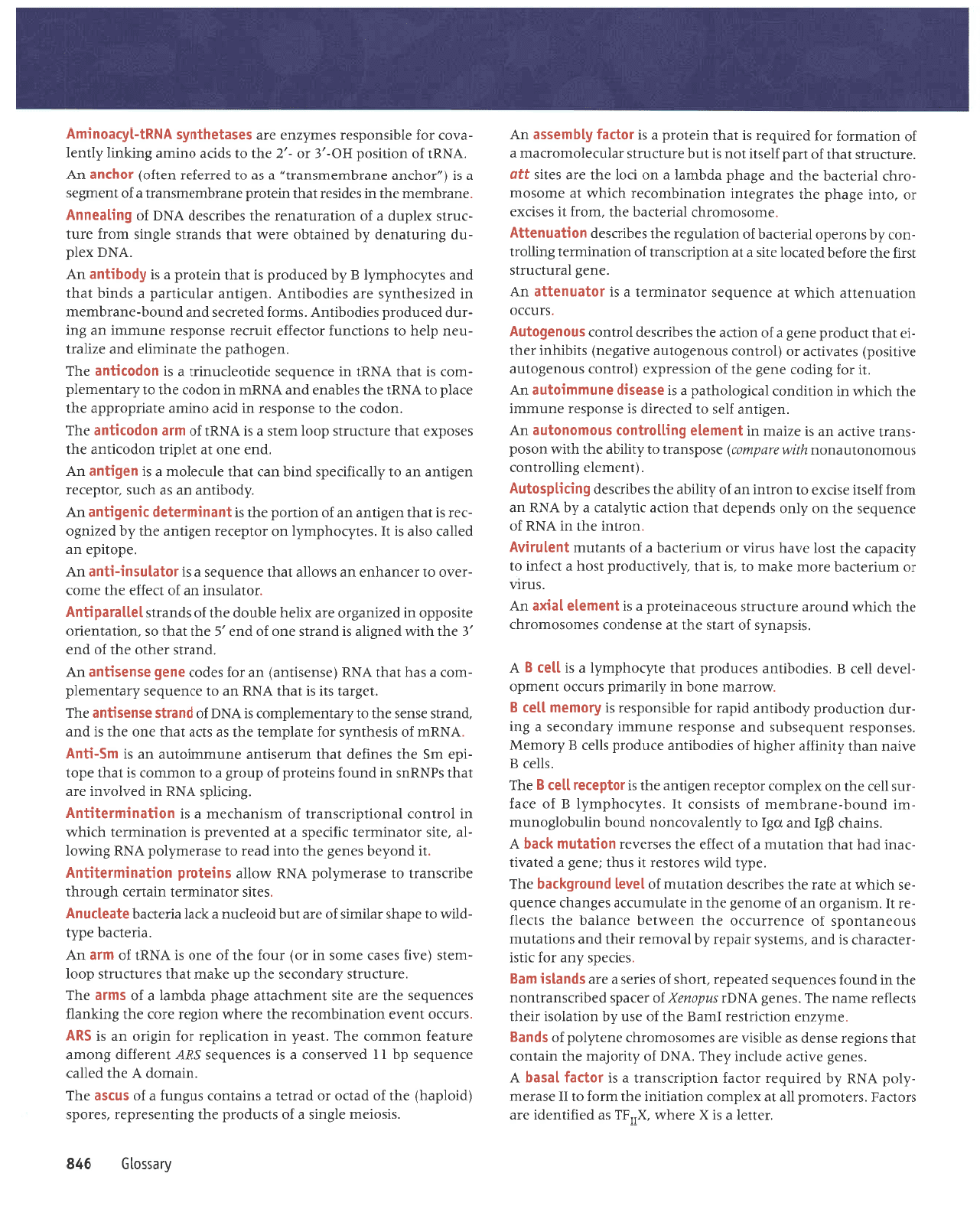
'rallal
e sr
x
araqM
'x"{J
sP
parJrluapr
erP
sJolJec
'sralouord
IIP
1e
xaldruor uorlerllul
eql ruJoJ ol
II
aseJeur
-[1od
ygg
dq parrnbar
rolrpJ
uorldrr)suprt
p
sr
Jol]p]
lpseq
V
'saua8
a,rtDe
apnlJur,taql
'VNC
;o
,i.1rrofeur aqt uretuoJ
leql
suorEar esuap sp alqrsrl
eJp saruosoruo-rqr aual,{1od
Jo
spueg
'aru.{zua
uollJlrlsal
Irupg
eql;o asn ,{q uorlplosr
Jreql
sDelJar aureu aqJ
'saua8
y111qr
sndouay
1o
rareds
peqrrJsuerluou
aqt uI
punoJ
saluanbas petpada.r
'uoqs
Io
sarras
p
arp
spuelsl ueg
'saoads
Aue ro;
rrlsr
-reDeJeqJ
sr
pup
'suelsr{.s
rredar ,{q
le,rouar
rleql
pue
suorletnru
snoaueluods
Jo
aruarrn)Jo
aql uaamleq
eJuplpq eqr st)elJ
-ar
11
'rusrue8ro
up
Io
aruoua8 eql ur alplnurnle
sa8ueqr aruanb
-as
q)rqM
lp
etpr
Jqt saqrrrsep
uortetnruJo
1ala1
punolElleq
eql
'ad,,(1
ppra
sJrolser
tl
snql
laua8
e
patp^lt
-Jeur
peq
lpqt
uortelnu
p
Io
lJJlJa
aql sesre^ar
uo$elnu
lrpq
v
'sureq)
f,31
pue
n31
o1 .{11ua1elo)uou punoq
uglnqolSounru
-urr
punoq-auPJqureur
Jo
slsrsuoJ
tI
'sat.rlroqdurr(l
g
Jo
aJpJ
-rns
IIaJ
aql uo
xaldruor rotdarar
ua8rlue aqr
sr
roldatal
llel
g eq;,
'sIIe]
g
e^Ipu
uPql ,{tlulJJe
raq8rq
Jo
sarpoqrtue
arnpord sllal
g
,,(rouary
'sasuodsar
luanbasqns
pue
asuodsar aunruurr ,{repuoras
e 8ur
-rnp
uortJnpord.{.poqrtue
prder
ro;
alqrsuodsar s1
fuoueu
11ar
g
',t,rorreru
auoq ur .,{perurrd
sJnJ)o
luarudo
-la^ap
IIe)
g
'serpoqrtue
sarnpord
reqr
ar,{roqdurz{1 e sr
lle]
g
V
'srsdeu,{s
Jo
upls
Jr{l
lp
Jsuapuo) saruosoruoJq)
eql r{Jlq.tr
punorp
ernDnrts
snoeJpurelord
p
sr
lueuele
lelxe
uV
.SNIIA
ro
runrJJDeq eroru
J>leur o]
'sr
tpqt
'{1a,r1trnpord
lsoq
p
lJJJur
ol
.{tneder
eqt
lsol
elpq
snrrl ro runrJatJeq
e
Jo
stuptn{u
luelilJAV
.uorlul
aql ur
vNu
Jo
aruanbas
aq1 uo .{1uo
spuadep
tpql
uorlre rrt.{lBter e .{q
y51g
ue
ruorJ
1lastr
asDxe
01 uortur
ue
Jo,{1rtrqe
aqr
saqrrJsep
6upgdsolny
'
(tuaurale
Surllortuor
snourouolneuoutlltm
atadwot)
asodsuerl o1 ,{1qrqe
aqt
qtpl
uosod
-suerl
elrt)p up
sr azreru
ur
luauala
Euglorluor
snououolne
uV
'ua8tlue
JIas
ol
pJpaJrp
sr asuodsar aunrurul
aqt r{rrqm ur
uorlrpuoJ
lerrSoloqted
e sr
aspasJp aunuurolne
uV
't1
ro;
Surpor
aua8 aql;o
uolssardxa
(1or1uor
snouaSolne
a,rrltsod) selpAIlJp
ro
(1or1uor
snouaSolne
aarleBau) sflqlqul
raql
-Ia
teql nnpord
aua8
e
1o
uorDe
aql saqrrrsep
Iorluor
snouaEolny
.SINJJO
uortenuallp
qrlqm
le
aruanbas rotpulurral
p
sr
tolenuelle
uV
'auaB
Iernlrnrts
lsn}
eql aroJaq
prlPJol
alls
e
le
uolldtDsuerl;o
uorleururral 8u111orl
-uor
.{q
suorado
lerralreq;o
uorteln8ar
eqt saqrrrsap
uogpnuanv
'aruosourorqJ
lerJalJpq
eql
'uoJJ
1l
sasrJxJ
ro
'olul
a8eqd
aqt salerSalur
uorlpurquro)ar q)rq,t.r
lp
aruosoru
-orqJ
lerret)pq
aql
pue
a8eqd epqruel
e uo rrol
eqt eJe salrs
llD
'arnlJnrls
lPql
Jo
lred
JIaslr
lou
sl
1nq
aJnl)nrts relnJalouror)eru
p
Jo
uorteurroJ roy pa:rnba,r
sr
tpql
uralord e sr
tope; /[lquasse
uy
&esso19
918
'srsoraur
a13urs e;o spnpord aqt Eupuasardar
'serods
(proldeq)
aql
Jo
pepo ro perlel
p
surpluo) sn8un; e
Jo
snlse
aql
'urPuop
v
aql
pellPr
aruanbas dq
11
paa.rasuoJ
e sl saruanbas
S:Uy
luaraJJrp
Suorue
JJnleeJ uoruuro)
aql
'1sea,{
ur uorlerlldar ro; ur8rro up sr
SUV
'sJnJJo
luena
uolleurquoler aqt
eJeqm uorSar
arof, eql Suqueg
saruanbas aql arp alrs
lueurqJette
a8eqd
ppquel
e
Jo
stu'tp
er{J
'arnlJnrls
d.repuoras aql dn a>leru
leql
sarnlrn-r1s dool
-rua1s
(a.,lr;
seseJ aruos ur ro) rno; Jql
Jo
euo sl
VNUI
Jo
uJe
uv
'erralreq
adzb
-plrm
ol adeqs
relnurs
Jo
arp
lnq
proalJnu
p
>lrel
prraDeq
aleellnuV
'salrs
JoleulruJal ureueJ q8norqr
eqrrJsupJt ol asereru.dlod
VgU
Molle
sulelord
uo$puJruJat$uv
'r1
puo,{aq saua8 aqt otur
pear
o1 aseraru.dlod
VNU
8uu,ro1
-lp
'alrs
roleurrural rr;nads e
le
peluanard
st uorleutuJel
q)rr{,vr
ur
Iortuo)
leuorldrnsuert
Jo
rusrupqreru e sr
uorleuJural$uv
'3uo11ds
VNU
ul
pellolur
ere
tpqt
sdNgus ur
punoJ
suratord;o
dnor8 e
ot uoururoJ sr
1eq1
adol
-rda
urg aql saurJap
lpql
runrasrlup aunururrolne uB
sr
ruS-FuV
'yNgru;o
srsaqluls ro; a1e1drua1 aql se slJE
lpql
auo eqt sr
pue
'puprls
asuas aql o1
,fupluJruJldruoJ
sr
vNC
Jo
pue4s
osuasgue
aqJ
'leErPt
stl sI
leql
VNU
ue ot aruanbas [reluaruald
-ruoJ
p
seq
lpql
y51g
(asuasrlue)
ue JoJ sapo)
aua6 esuesnup
uV
'puPrls
raqto
eql
Jo
pue
,€
Jqt
qlIM pau8rle
sr
puerts
auo
Jo
pua
,S
eqr
tpqr
os
'uorleluarro
atrsoddo ur
pazrue8ro
are xllaq alqnop eql
Io
spuerts
lalleledpuy
'Jolelnsur
ue
Jo
peJJa
aql eruor
-relo
ol raJuequa ue smolle
leql
aruanbas e sr
rolelnsu!-llue
uV
'adolrda
ue
palleJ
osle s1
11
'sailroqdru,{1
uo roldarar ua8rlup
aqt ziq
pazruSo
-)Jr
sr
lpql
uaErtue
ue;o uoruod eqt sl
lueuJulalap
rlue6gue
uy
',{poqttue
uP se
qJns
toldarar
uaErlue ue ot,{llBtrJoads
purq
ueJ
lpqt
eln)eloru e s1
ua6pue
uy
'pua
auo
re raldln
uopoJrluP aql
sasodxa
lpql
arnt)nJts dool ruats
p
sl
vNUl
Jo
rulp uopotJlue
eqJ.
'uopoJ
aql ol asuodser ur
pr)p
ourrre alerrdordde
aq1
areld o1
y1.1gl
aqt salqpua
pup
vNgru
ur uopoJ
eq1 ol ^retuaueld
-Iuo)
sI
teql
VNU]
u1 acuanbas aplloel)nuut
p
sr
uopolque
aqJ
'uaEoqted
aql aleuFulla pue
ezllerl
-nau
dlaq ot suorlJunJ JoDeJJa
UnrJer
asuodsa-r eunuurl
ue 3ur
-rnp
pa)npord
sarpoqrluy'sruJoJ paterJes pue punoq-euerqueu
uI
pezlseqlu,{s
are sarpoqlluv
'ua8rlue
relnltred
e spurq
teql
pue
salboqdu,{1
g
.{q patnpord
sl
lpqt
ulalord e sr
fpoqque
uy
'ygq
xeld
-np
Surrnleuap ,{q
paurelqo
eram
tpqt
spupJls a13urs uror;
arnl
-rnr1s
xaldnp
p
Jo
uorlprnlpueJ
aql seqrJJsep
VNq1
Jo
Eupeauuy
'auprqruaru
aql
rn sJprsar
leql
uraloJd eueJqruarusupr
e;o
luaru8as
e
sr
(,,roqrue
euerqureursuett,, e se ol
perraJer
uago)
roq:ue
uy
'VNul
Jo
uolllsod
Ho-,g
ro
-,2
erft
ol sprJe oulure Suquu
{pua1
-eAoJ
roJ alqrsuodsar satu,{zua
are
sesploqlu/is
y11X11/i:eoulluv
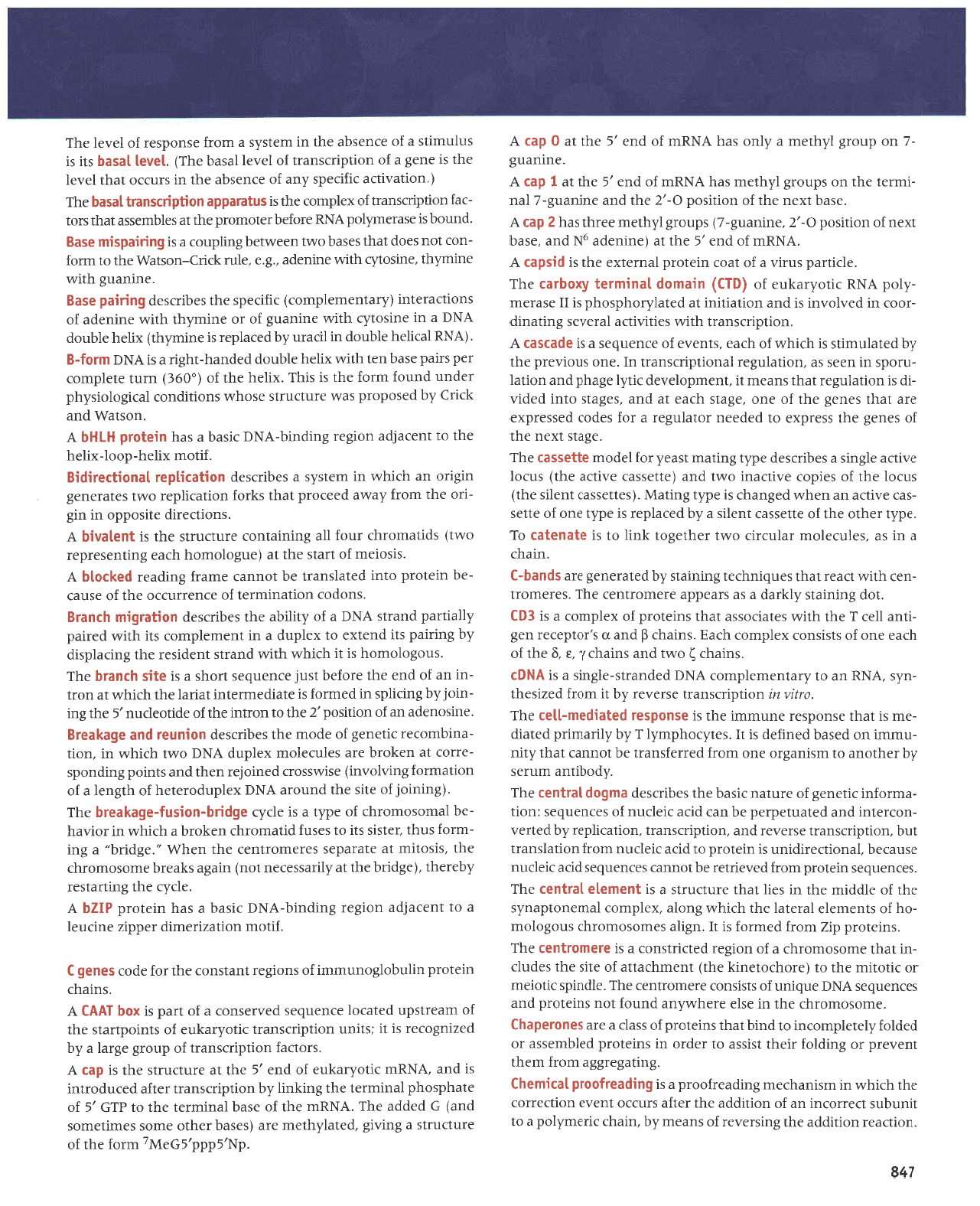
L'8
'uorJ)per
uorlrppp
Jql Sursra^er
Jo
suearu..{q'urpqJ
Jrrau^lod e 01
llunqns
l)aJJoJur
uP
Jo
uorlrppe eql
Je4p srnJJo
lua^e
uorlJerro)
aqt
q)rqm
ur rusrueqJaru
Surpear;oord
e sr
6ulpearloord'1er1ueq1
'?uqe3at88e
ruorl ruJql
tuenard
;o 3utp1o; rraqt
tsrsse
ol repro
ur suralord
pelqurassp
ro
peploy
LlatalduroJur
01
purq
teqt
suratord;o sselJ e erp
seuoradeql
'auosouorqr
eqt ul asla araq,u,{ue puno}
lou
suralord
pue
saruanbas
y111q
anbrun;o slsrsuoJ
aJaruoJlua) aq;'apurds
Jrloreru
ro )rtolrru aqt ot
(aroqtoteur>l
aql)
tuauqrplle
Jo
alrs aql sapnlr
-ur
leql
aruosoruorqJ e;o uor8ar pal)lrtsuoJ
p
sr
ereuo.tlual
eqJ.
'sutalord
dt7
uror;
paruJoJ
sr
11
'u311e
saruosourorqr snoSoloru
-oq
Jo
slueuala
Ieralel
eqt qJTqM
3uo1e
'xaldruot
leruauoldeu,(s
eql
Jo
alpprur
eql
ul sa{
leql
erntJnJls
e sr
lueuala
lellua)
eqJ
'saruanbas
uralord ruor;
pelarrler
aq
louupJ
saruanbas prJe
Jral)nu
JSne)eq
'lpuoIlJerlpIun
sr uralord ol plJp
)ralf,nu ruorJ uorlplsuEJl
1nq
'uorldrnsueJJ
asreAer pue
'uorldr-rrsuerl
'uorlpJrldar
.{.q
pagaa.
-uoJralul
pue palenladrad
aq upJ
prJe
tralJnu;o saruanbas :uorl
-pluroJul
rtteua8
Jo
ernteu
Jrseq aqt seqrrrsep
eruEop
letluel
aql
'Apoqrlup
urnras
.r{q raqloue ol rusrue8ro
Juo uroJ}
parJeJsupJl
aq
louueJ leql
^l1u
-nururl
uo
paseq paurJap
s1
t1
'saldroqdu,{1
1.{.q.{perurrd
paterp
-eru
sr
teqt
asuodsar
eunururr aql sr
asuodsat
paleJpeu-llal eqJ,
'ottrA
u! uorldrnsuprl
JSJJ^Jl
,{q
tr
uo.r;
pazrseql
-u,,(s
'y51g
up ol .{relueuralduror
vNC
pepuerls-a18urs
p
sr
VNOI
'surPq)
)
o^r
puB
sureqt /,
'3 'g
aql
Jo
q)pe
auo
Jo
stsrsuoJ xalduror qJef,
'surpqJ
$
pue
n s,roldarar ua8
-ltup
IIrJ
I
Jqt
qll,tr
srlpr)ossp
teqt
suratold;o xalduo:
p
sl
€0J
'top
3u1u1els
d1ryep
e se sreadde
araurortue) aqJ
'serauorl
-ua)
qlrM
lJear leql
sanbruqral Sururets dq pateraua8
are
spupq-l
'urPqJ
e ur se
'salnJalou
rplnJrrr
olvrt reqleSot >lu{ ol sr
alpualel
oI
'adri.t
raqto aql
Jo
allasseJ
tuelrs
e.dq
parelder
sr ad,{.t auo
}o
allas
-sef,
alrt)e
ue uaq,tl
pa8ueqJ
sr ad.{t Surtew
'(sallasser
lua1s
aqt)
snJol aql
;o
satdor alrtJeur oMt
pup (atlassBr
a,.r.rlre
aql) snrol
anrpe a18urs e seqrrrsap adLt SurlBru
lsea,{
ro;1apou€Uassel eqJ
'ebPls
lxeu
eql
1o
saua8 aqt ssardxa 01
papaeu
-rolelnEar
e
roJ
sapoJ
passardxa
are
teqt
sauaE aql
Jo
euo
'a8e1s
qrea
tp
pup
'sa8ets
otur
peprl
-rp
sr uorlelnSer
teqt
suprru
tr
'tuarudolaa.ap
rp[1 a8eqd
pue
uorlpl
-mods
ur
ueas se
'uorleln8ar
leuorldrnsuerl
uI
'auo
snor,Lard aql
dq
patelnrups
sr
q)rqM
Jo
qree
'stuele
;o
aruanbas
p
sr
epplsEl
v
'uotldrl;suer]
qlrM
sJurArl)e
IerJAJS
Surteurp
-rooJ
ur
pe^lo^ur
sr
pue
uollellrul
1e
pa1e1,{.roqdsoqd
sr
II
aspreu
-.{1od
ygg
rr1o.{:e1na
Jo
(011)
ulptuop
lpuJu.tel
/[xoqter
aq1
'aprlred
snrll e
Jo
teof,
uralord
Ipurelxe
aqt sr plsder
y
'vNuru
Jo
pua
,s
eql
le
(euruape
eN
pue
'eseq
lxeu
Jo
uortrsod
O-,2
'eulupnS-1)
sdnor8
1,{qraru
earql spq
Z
der
v
'espq
txeu
egt
Jo
uorlrsod
9-,6
aqt
pue
euruenS-1
1eu
-rurat
eql uo sdnor8
1{qrau
seq
vNuru
Jo
pue
,E
eqt
te
I
dpl
V
'auluend
-4
uo dnor8
l.dqtaru
e Lluo seq
vNgru
Jo
pua
,E
Jqt
tp
O
del
V
'dg,Eddd,ggewr
ruroJ aqt
Jo
JJnt)nrls
e 3ur^r8
'pare1,{qraur
are
(saseq
Jeqlo
auros saurllauos
pue)
g
peppe aql
'vNuru
aql
Jo
aspq
lpururJal
aql
ot
dJ,c
,E
Jo
areqdsoqd
leultural
aqr 3uu1u11
,{.q uorldtpsuPrl
relJe
paJnpoJlul
sr
puP
'vNuur
rtlo.dre>Ina
Jo
pue
,E
aql
le
arnl)nrls
aq1 sr
der
y
'srolf,pJ
uorldursuBrl;o
dno;E a3re1 e ,i.q
pazruSorar sl
1l
lstgn uottdtnsuerl
rrloLrelna
;o
slutoduets
aql
;o
ruearlsdn
peteJol
aluanbas
panrasuof, e;o
lred
sI
xoq
lVVl
Y
'surEqJ
ulatord
ulnqolSounrurur;o
suot8ar
luetsuo)
aql roJ apor
saua6
I
'Jrlou
uorlezlretulp
raddtz autrnal
e ot
tuarelpB
uor8ar Eurpurq-ygq
rlspq e seq uralord
dIZq
V
'ap,{r
aql Euu.relsar
,{qaraqt
'(a8prrq
aql
tp
^IresseJau
lou)
UIPBP s>lParq
auosouorqJ
aql
'srsolrul
le
alPredes selauroJlueJ
aql
uaqM
,,'a6prrq,,
e 3ur
-ruroJ
snqt
'ralsrs
sll o1
sesnJ
plleluorqJ ua>lorq
P
qJIqM
uI roIAPq
-rq
Ieuosoruorqr
Jo
ad,h e sr ap,{r
abppq-uolsnl-e6e{earq
eqJ
'(Sururo[;o
alrs eql
punore
y1qq
xaldnporateq
;o
qfual
e
;o
uorleruro;
Sur,rlorrur)
aslMssoJJ
paurofar uaql
pue
slutod
Eurpuods
-erro)
te
ua>lorq ere
salnJelou
xaldnp
ylqq
ozrtl
q)lqM uI
'uoll
-eurquotar
JrlJuaS
Jo
aporu
aql seqrJ)sap
uolunal
puP
e6qeelg
'eursouapp
up;o uoursod,6
aql ol
uorlul aql
Jo
apuoepnu,s eqt Eul
-uro[.{.q
Eunrlds
ur
pauro; sI elelpeluralul
tPlrel
eql
q]lqu
lP
uorl
-ur
up
Jo
pue eq1 aroleq
tsnf
a;uenbas
uoqs
P sI
alls
tlluug
aq1,
'snoSoloruoq
sl
1l
qJIqM I{II.tr
puens
luaplsar
aqt
Euoeldstp
Lq Surrred
stl
pualxe ot
xeldnp e
ur
luarualdruor
sll
qlpr,r parrcd
,{11errred
puprls
VNC
p
;o
,{.1r1qe
aql saqIJJSap
uoperElu
qluPJg
'suopo)
uollPulrurel
Io
e)ueJJnJJo
eql
Jo
asneJ
-aq
uralord
otur
pelplsuprl eq
touuPJ
aruer;
Surpear pallolq
V
'srsoreru
Jo
uPts
aqt
te
(an8olouoq
q)Pa
Surluasardar
orr.rt)
sppeuorqJ
JnoJ
1e
SututeluoJ
Jrnlrnrls
aql sl
luale^lq
v
'suollJeJlp
alrsoddo ur utE
-rro
aql
ruory
,{.eue
paarord
leql
$IroJ
uo1]el11da.r
o,ul saleraua8
ur8uo
ue
qJIqM ur ruals,{s
p
saqlr)sep
uoJlellldat
lPuopsarJplg
'Jrloru
xlaq-doo1-xqaq
aql ot
ruarefpe
uot8ar
Surpurq-ygq
JISeq
P seq
utalold
HlHq
V
'uosleM
puP
>prr3
,{.q
pasodord sem JrnlJnrls
esol{.tr
suolllpuoJ
prr8olorsz(qd
rJpun
punoJ uroJ eql
sl slq1,
'xqaq
eql
Jo
("09€) urnl alaldruor
rad srred
aseq
ual
qll.tr xlleq alqnop
papueQ-rq8u P sl
YNQ
lurol-g
'(ypg
prrraq elqnop
ur
grern.dq
pateldar st aunu,{qt)
x{aq elqnop
VNq1
p
ur aursolu(r
qtl,r,r auluen8
yo ro autu.r{.ql
qlIM euluape
Jo
suortreratul
(trreruarualduror)
rr;nads JI{l
saqlrJsep
6uu1ed
aseg
'auruPnd
qlrM
au[u,{q]
'ar4sorrb
qrpl
euluape
"E'a
'a1nr
pu:)-uosle^^
eql o1 uuo}
-uoJ
lou
saop
lPqt
saseq
o^tl uaaa^leq
Surldnor
e s1
6up1eds1u
aseg
'punoq
sr aspraurdlod
yyg
aroJaq
raloruord
aql
le
salqruesse
leql
srol
-re;
uortdprsuerl
yo xaldruoJ erp
sI
snleredde
uo;1dgrsue4
leseq
aqJ
('uolle.nDe rr;rtads
z(ue
;o
aJuasqe
aql uI
srnJ)o
1eql
la^el
aqt sr aua8
p
Jo
uoudlrf,suert
Jo
Ie^aI
pseq
aql)
'1ana1
lesPq
s1I sI
snlnurls
p
Jo
aJuJSqP
aqt ur
rua1s,{.s P
IuoJJ asuodsar
}o le^el
eql

'suralord
Io
llrueJ
)ws
eqt
Jo
sJJqlualu
aJe ^eqJ
'srsolrur
Jo srsoreul
JoJ uorlpsuJpuof,
asneJ ol seurosolu
-orq)
ot sprnq
lpql
xrldruoJ
e
Jo
stueuoduor
arp suretord
usuapuo3
'snro1
a13urs e
Surlnlrlsuor
q8noqr
se raqlaEol aAIoAe
ot saua8
paleler
oMt
Jo
,(tlllqe
aqt saqrrJsap
uoJlnlo1a
pepeluo3
'aua8
arues
aql ur suorlplntu
lou
^lqp
-qord
are
pue
reqlo
qJee
luatualdruo)
ol
pres
JJp
suorletnur aq1
'os
y
'parnpord
eq ue) ad.drouaqd
adLl-plaa eqt reqleqM
Surunural
-ap
puP
addlouaqd
arups eql
eleq
leql
suorlplnur
elrssa)ar
luereJ
-JIp
oMl SurssoD ,{q paqslldruoJrp
sr
tI
'aua3
alups eqt
Jo
selelle
erp suorlplnru
o1!\l raqlaqM
seururJalap
lsel
uollEluautalduo)
y
'(uorlstr
aql)
uun
JIlaueS P
saurlep lsuoJl
rrr
suorlpurqurol
asr,,urred
ur
palsel
uaq,Lr
luaurald
-ruoJ
ol alqeun
suorlptn{u
Jo
sarres
p
sr
dnol6
uogeluatualduor
y
'(9
qlle\
)
pue
'vNU
ul
n
qllm
lo
VNO
ur
J
qlr,lr
y)
spne Jrelrnu
Iprlleq
elqnop
ul suorlJprr
Eurrred aql
,{q
pauryap
are srred
aseq
/fuelueualduol
'adz(louaqd
adft-pplzr
aql sarnpord
uortplnur qrpe
ro;
sno8Lzoralaq sr
tpqt
ploldp
p
uaqM reqto q)pe
lueualduot
ol
prps
arp stuplnur
ol4l
'lleJ
lerJal)pq
Jures
aql ul
lsrxeo)
01 alqpun sraquraur
suletuor
spnuseld yo
dnotb /$ylqpeduor
y
'sprJe
ourure
;o
aluanbas
p
ur saprloal)nu
1a1drr1
;o
aruanb
-es p
Jo
uorleluasardar
I:I
aqt seqrrJsap
drqsuorlelar
reaullol
V
'sleada.t
l)aJrp
sp
peluJuo
'suo:r1dar
aqt.;o
suorpunI qloq
le tuasard
uosodsuerl
aql
1o
sardor
seq aler8aluror
aqt
111
Suqrel reqlo
eql pup
uosodsuerl
B
Surssassod [lleur8rro
auo
'suor[dar
o,lrt
]o
uorsn;,{.q parnpord
sr arnDnrts
a1e.r6a1u1o:
y
't1un
a13urs e se raqlaSol
aAIoAe
saua8 oalt qJIqM
ur
uortentrs
p
saqrrrsep
uognlone
lelueplrulol
'suratord
JWS
Jruos
apnpur z{aq1
'xaldruor
leruauoldeu,{s
eql urqtrM raqlaSol
sprtpu
-orqJ
Jalsrs sploq
leqt
xaldruot
Ieralpl
e
uJoJ suratord
uJsaqol
'pr)p
ourrue erues
aql qrpn pa8reqr
are
1e.daq1
.aselaqluds
y1qg1
-1,{.reourtue
relnllred
e /.q pazruSof,er
asoqt^erp
sy1,1g1
a1eu6o1
'lPubrs
uorlPururrJJ
e Jo
plf,p
oururp
ue sluasardar
tpql
saplloal)nu
Jo
ta1d14
e sr
uopol_v
'sluaseroer
1l teql
e)uanbas
uralo-rd
eq1 ot epoJ
;rlauaE
aqt ,{q
paleler
sr
pue
VNUIU
aqt se
e)uenbas
arues
aql spq
vNe
Jo
pupJls
6u1por
aq1
'aruanbas
uralord
e sluasardar
leqt
aua8 aqt;o
ged
e sr
uo16al
6u1pot
y
'1uro[
Surpor e
splarz{' spua Surpor
aql
;o
Eururof
luanbasqns
aq;'suor8ar
Surpor
f
(O) pup
A
pa^eap
aql
Jo
rurruJat
eql
te
ere spua
3upo3
'sauaE
roldarar
IIe)
I
pue
ulln
-qolSounruurr
Jo
uortpurquorar
Surrnp parnpord
sr pua
6u1por
V
'srol)PJ
uorldursuerl
Ipseq
Jql
r{U,lr
perelur
ot srolelrpp (Supurq-y51q)
ro; parrnbar
erB
tnq
,VNC
purq
tou
op
leqt
uoqdrrJsuerl
roJ parrnbar
srolrpJ arp
s.tolellpeo3
'sdoo1-rure
Dullsrp
rno;
Sunuro;
,suolsuaru
-lp
o^rl ur uMeJp
vNul
Jo
arnl)nrts
aql saqrr)sap
Jpalre^oll
aqJ
ftesso19
878
',{Solounururr
ur aldourrd
paqsr1qelsa
up
,lrou sr uorlf,alas
puol)
'petplrDe
aq
or sadloqdru,(1 aql
,,slrJlas,,
ua8rlue aqt
'snql
'uaSrlue
teql
Eulleulurrla ur uorlrunJ
ol
pue
atera;qord ot
pelelnrulls
are ua8tlue uanr8 e o1
purq
lBqr
sailroqd
-ruL1
asoqt.{1uo
leql
pue
zfuogoads rolderar ua8que
a13urs e sassa:d
-xa
a1l:oqdruz{1 qrea
teqt
pasodord
uhoaqt
uolpalos
leuol)
aq1,
'uaSrluB
JteuSo) rraqt ot purq
sJol
-darar
ua8rtue a/:oqdru.dl ueqM
pernpur
eq ue) uortelap
leuolJ
'luarudola,rap
a1,{.roqdru.d1
;o
sa8ets ureual
1y
'saldroqdurLl
yo
uorlelndod
IpuolJ
e
Jo
uorlpururla aql saqrrrsJp
uollalop
lpuoll
.SIIEJ
IEIJ
-apeq
pas[1
,{1uo sureluor
teqt
anbeld;o ad.d1 e sr
anbeld tpel]
V
eruPs
eql sureruar uor8
-er
A
eqt
1nq
pa8ueqr
sr ureq) [,reaq aqt;o
uor8ar
)
eqt
q]rqu
ur uorlpzrue8ro aueE 31
ur aSueqr
p
saqrrJsap
6u1q:11lyts
sse11
'>lroJ
uorlP)rldar aqt
te
YNC
o1 uo durep
$
aqr
Surpeol roJ elqrs
-uodsar
s1
leql
xaldruor uralord
tlunqns-g
e sr
Jeppol
durelr
aql
'aua6
e ol
lualeurrnba
sr
1r
ltset
uorleluarualdruor aql ,{q
pauqap
tlun
rpaua8 aqt sl
uotlsJt
V
('pazrsaqtuls
seM
tr
q)rqm
ruorJ
yNU
Jo
vNC
aqt uo
.d1uo
1re
ol
peurerlsuoJ
sr
1l
uer{,lr
lupurruop-r7J
sr uratord
e
leql
st uotldarxa arer
y)
'1rnpo:d
JlqrsnJJrp e roJ Jpor
tou
seop atrs
e
leqt
elPJrpur ol ue>Iel sr a)ueurruop-sj,
'vN(I
Jo
aln)eloru
ullto
s1r
1o
zlpo sartradord
aqt sDeJlp uollplnrulo atls
lueuJuop-s!, V
'ulaloJo
JoJ
epoJ
1ou
saop
alrs
eqr
teql
saldrur,{.1pnsn,{}radord slql 1(VNU
ro)
VNC
Jo
elnralou
urlro slr uo saruanbas
;o
dpo z(lra,rlre aqt sDeJlp
alrs
6utpe-s.D
V
'VNe
Jo
alnralou etues
Jr{l uo satrs oml seqrnsap
uo4ern8rJuo)
s.t,
'slsolaul
Jo
lrels
aql
lP
seuros
-oruorq)
snoSolouoq
aqr
yo
3u11dnoJ aqt sr
6up1ed
euosol.uolqJ
'uorsrlrp
1er
Eurrnp z(luo zbuua
prrEoloqdrou
p
sp alqr
-stn
sl
tI
'sutalord
Jo
sseru
lenba
zllaleurxordde
up
pup
y111q
xald
-np
Jo
alnJaloru
3uo1 fta^t e;o slsrsuof, aruosouorql
qteg
'saua8
z(ueur
Eurz(rrer auroua8 aqt
Jo
trun
elerJsrp
p
sr
auosotuotql
V
'seJeruoruoJq)
Jo
serras
p
Jo
lsrsuoJ
o1 readde rleru
aurosoruorql
e
uaqm'srsoreru ur dpea
[lenadsa
'suorlrpuoJ
ulpueJ rapun
seuros
-oruorq)
ur elqrsr^
salnuer8 Sururels z{yasuap
are
setauouottll
'seuosouroJqJ
lueJeJ
-Jrp
urorJ urtpuorq)oJaleq
Jo
ale8ar8Ee
up sr
talualouotql
JqI
'uollduJsuerl
ro;
sauaS
Jo
uorlplrlJe qllM
uorl
-runluor
ur
sJnJ)o
lpql
sauosoalf,nu
Jo
uorlezrueS.roal
Jo
]uJru
-areldsrp
ruapuadap-L8raua
aql seqrrrsap
6ullapouel
u
geuorqJ
'alJAJ
IIaJ
)r1o
-,{re4na
aql;o
(sasolrur
ueaazrlaq) aseqdralur
aql Surrnp
suratord
palerrosse
sll
pup
vN(
rpalrnu
Io
alpts aql saqrJ)sep
ugptuoJq]
'uorsrlrp
1ar
luanbasqns
aqt
lp
aleredas ,{aql
aro;aq
porrad
aqt
ur sardor
aqt
Jo
qJpa
aqrJJsep
ol
pesn
,r{lensn
sl arupu
eql
'uorl
-ellder
,{q parnpord
rrrrosourorqr
e;o sardor
aqt ere
spgeuolqf
'srsoraru
Surrnp
lerJeleru
paEueqrxa
aleq
01 readde
seruosour
-orqr
snoSolouoq o,lrl qJrqM
le
elrs
p
sr
(eleruserqr
7d)
eruselqr
y
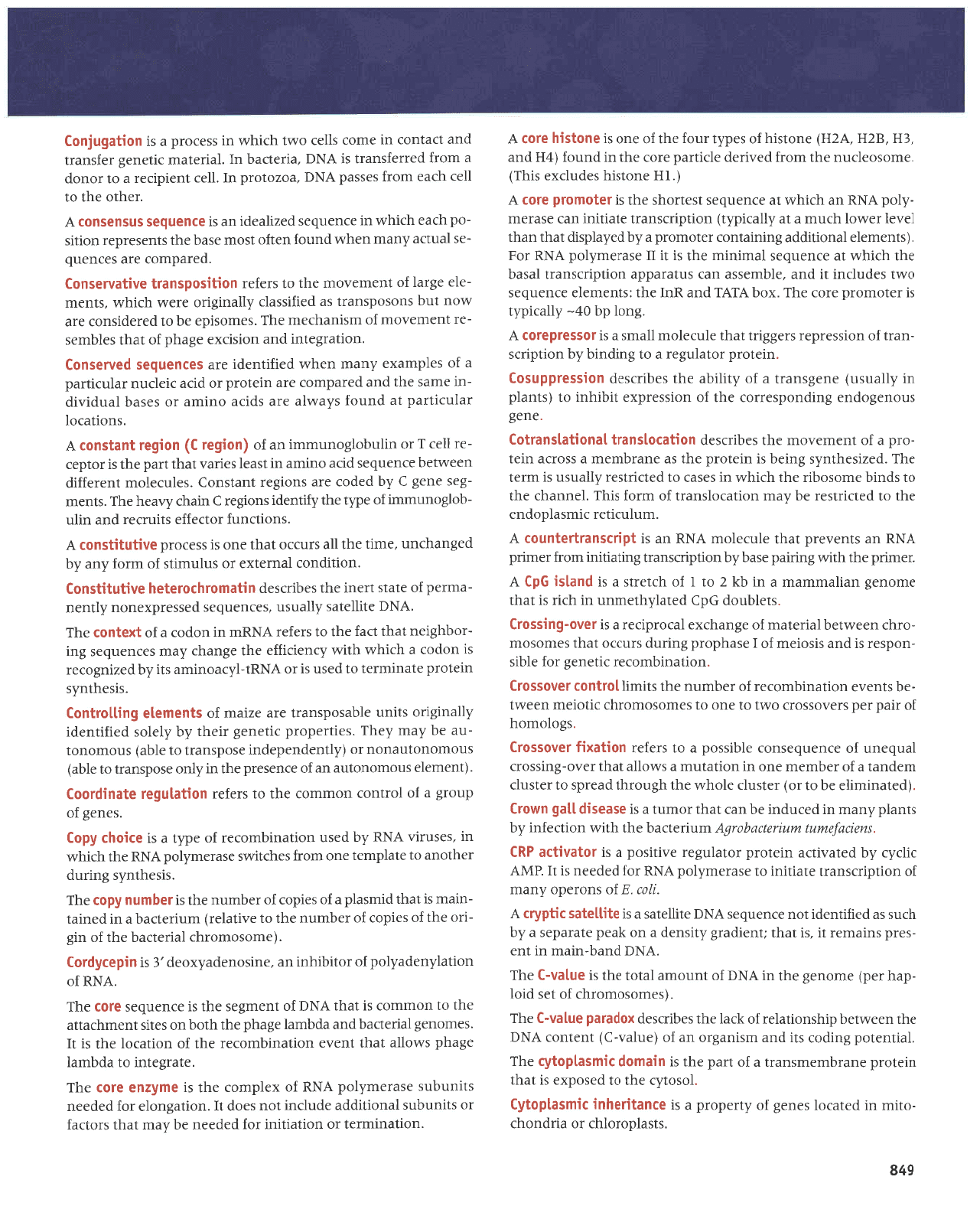
618
'slseldorolqJ
Jo eupuoqJ
-ouru
ur prtprol
srue8
Jo
Luedord
e sr
atuplpequt
lluseldolfl
'1oso{r
aql
ot
pasodxe
sr
leql
utalord auprqluarusuerl
p
Jo
ued
aqt
sr
uleutop
tlruspldoill
eqJ
'ppualod
Surpor slr
pup
rusrue8ro
ue;o
(an1ea-3)
ruaruot
ylqq
aql uaaa,ttaq dlqsuollpleJ
Jo
>lJel rqt
sJqrJJSap
xoppJpd
anlp6-J
eqJ
'(saruosoruorqJ
Jo
les
prol
-deq
rad) aruoua8 aql ur
VNq
Jo
tunoure
Iplol
aqt sr
enlen-l
eqJ
'vN(
pueq-urPru
ur
Jue
-sard
sureural
lr
'sr
leql
ltualper8
Llrsuap e uo
lead
aleredas e,{q
qrns
sp
parlrtuepr
lou
aluanbas
VN(
erllares
p
fl
elnlales
lgdfur
V
'lll'E
Io
suorado
,{ueu
;o
uorldrnsuer etep1ul o1 aseraur.{1od
VNU
roJ
pepaeu
sl
1I
AhlV
r1p.dr ,{.q
patellt)p
uletord
roleln8ar aartrsod e sr
.tolenJpe
dUJ
'suanalawry
wnualtaqotCy
unrJeDpq aql
qllu
uorpa;u1 ,{q
slueld,{uBru
ur
paJnpur
aq ueJ
leql
rount
p
sr
eseeslp
llp6
u/v\otl
'(pateunutla
aq or ro) ratsnlJ
JIoqM aqt
q8norqt peards
01 ralsnlJ
urapuPl
p
Jo
Jaqrueu auo ul uorlelnur
p
sMollp
leql
rarro-SurssoD
lenbaun;o
aruanbasuor alqrssod
e 01 sraleJ
uollpxll JaAossoJJ
'sEolouroq
;o
rted lad sra,rossot) oMl 01 auo ol
sauosourorqJ )rloreru uaeMl
-aq
slua^a uorleurqruorrr
Jo
requnu aq1 slluq
lotluol
re^ossoll
'uorleurquro)ar
rrlauaB roJ alqrs
-uodser
sr
pue
srsoreru;o
1
aseqdord Surrnp srnJJo
leql
saruosoru
-orqJ
uaamleq
Ierraleu;o
aEueqrxe
lerordoar
e sr
i3nq-fiu1959.t1
'slJlqnop
9d3r
patelr(qlJurun
uI
q)Ir
sI
lPql
aruoua8 uprlpurueu e ul
q{
Z
ot
I
Io
qJterts
p
sr
puplsJ
Cdl
V
'raurud
aql
qtl^{
Suurpd
aseq,{q uoqdursuerl 8uuerllr4 uor; raurgd
yNu
ue sluanard
teqt
alnrelou
VNU
ue s1
ldpnsue.rpaluno)
v
'tunln)rlJr
:ruseldopua
aql o1
paDrrlsar
aq zi.eur uortP)olsuPrl
Jo
ruJoJ srr{J
'leuueqJ
Jql
ot spurq
aruosoqrr aqt qJrqu
ul saspr 01
pelJrJlsJr
,{lensn sr rrrJal
eqJ
'pazrseqtuls
Suraq sr uralord
eqt se eueJqureru e ssorJp ulel
-ord
e;o
tuerueloru
Jqt seqrrlsap
uollp)olsuerl
lpuoJlplsuetlo1
'euad
snouaSopua EurpuodsauoJ aql
Jo
uolssa.rdxa
llqlqul
o1
(s1ue1d
ur Lllensn) aua8suert e
;o
,{.1r1qe
aqt seqrrrsrp
uolssalddnsoS
'uratord
roleln8ar e o1 Surpurq.dq uortdrns
-uerl
Jo
uorssardar sraSSrrt
teqt
alnrelour
Ilprus
p
sr
tossatderol
v
'Euo1dq
97-
,{.1errdL1
sr
ratoruord ero) ar{J
'xoq
yJVJ
pue
Uq
eql
:sluJruele
aruanbas
o1vll SapnlJul
rl
puP
'Jlqluasse
uer snleredde uorldrrlsuerl
Ieseq
eql
qJrqM
le
aruanbas
lPurruru
aql sl
11
1
ase.raruLlod
yNg
ro4
'(sluaurala
puoprppe
SururetuoJ raloruord e Lq
paz(eldsrp
teql
ueql
Ie^el
rauol
qf,nru
e
1e.{1errd,{])
uorldursuert alerlrur ueJ aseraru
-[1od
ypg
ue
qJrqM
le
aruanbas
lsauoqs
aql $
telouotd eto)
V
('111
auorsrq sapnpxa srql)
'aruosoalrnu
aqt ruorJ
pa^rrep
aprlred erof,
eqt ur
punoJ (?H pue
'€H'gZH
'y7g)
auolsrq;o sad.,(r rnoJ rql
Jo
Juo sr
euolslrl atol
V
'uorlpurrural
ro uollplllul
JoJ
papaau aq,{eu
lPql
srolJPJ
ro suunqns
Puorlppe
apnl)ul
1ou
seop
11
'uotleEuole
roJ
papJeu
slrunqns
aseraru,{1od
VNU
Jo
xaldruor aql
sr
eu/[zue
ero]
rq1,
'aler8alur
ol PpquPI
a8eqd
s,no1e
teql lua^e
uorleulquo)er
aql
Jo
uoltpJol
aql sI
1I
'sauroua8
leuappq
pue
epquel
a8eqd aqr
qroq uo satls
luaulqretlP
eqt
01 uoIIIIuoJ
sI
leq]
vNo
Jo
luaruSas
aql sr aruanbas
alo)
eqJ
.VNU
JO
uor1e1.duape,{1od
;o
rotrqrqul up'eulsouape/.xoap,5
s1
uldar/[p.to1
'(aurosoruorqf,
IerralJpq
aqt
;o
ut8
-rro
aql;o
sardor
Io
raqrrnu aql
ot a^llelar)
runtralreq e uI
peulel
-ureu
sr
leql
prruseld
e
yo sardor;o rJqlrrnu
aqt
q.taqunu
/[dor
aq1
'srsaqluz(s
Eut.rnp
raqtoup
ot atelduat
auo ruoJJ
sel{)ll,lrs eserauz(1od
yNg
aql
qJIqM
ur
'sasnrll
vNu
^q
pesn
uollpulquroJeJ
;o
ad,{1 e st
arloql /[do3
'saua8
yo
dnorS
e
Io lorluo)
uoruuroJ
eqt ot
sraler
uolleln6oJ
aleulptool
'(tuaruala
snoruouolnp
ue
;o
aluasard
aql ur
,(po asodsuel ot alqe)
snourouolneuou
ro
(,{puapuadaput asodsuerl
ol elqe)
snourouol
-np
aq
.deru .ri.aq1
'sattradord
rtlaua8 rraqr
,{.q ,{1a1os
patytuapt
.,{lleur8rro
strun
alqBsodsuerl
arp
azleur
Jo
sluauale
6u51o.t1uo3
'srsaqlu,{s
uralord
etpulurrel
01
pasn
sr
ro
yggr-1,{.f,eoulurP
s1r z(q
paztu8orar
sr uopor
e
qrlqu
qtIM ^JuaDIlJe
aql eSupqr
deru saruanbas
3ur
-roqq8reu
teql
peJ
aqt ol
sreJar
VNUtrr
uI uopoJ
P
Io lxoluol
aqJ
'yNO
alilales
zllensn
'saruanbas
passardxauou dpuau
-eurad;o
etpts
uaul
aql
saqlrJsap
ugpluorqlolalaq
elgnlllsuol
'uolllpuoJ
lPuJalxa
ro snlnurlls
Jo
rrrroJ ,{ue ,{q
pa8ueqrun
'aurl
eql
ile
sJn)ro
leql
Juo
st ssatord
olgnlJlsuol
Y
'suorDunJ
ropalJe sllnrJar
pue
uIIn
-qolEounruun;o
ad,{r
aqr z(;puapr
suor8ar
f,
qPqJ
d,Leaq aq1
'slueur
-3as
aua8
3
.dq
papor
are
suolSar
tuelsuo)
'salnJelou
luaralJlp
ueaMlaq
aJuanbes
pDe oulurp
uI
lseal
salrel
lPql uPd
aql s1 roldar
-rr
IIar
1ro
ullnqopounurrur
ue
yo
(uo$a.r
l)
uolEat
luelsuol
V
'suorleJol
relnrrlred
te
punoJ slearle
are spI)P
oulruP
ro seseq
IPnpI^Ip
-ur
Jrues
eql
pue paredruor are
ulelord
Jo
pIf,P
JIaIJnu
relnrrged
e
;o
saldruexa
,{.ueru uequ
palJltuapl arP
saluonbes
paruasuo1
'uotter8atut
pup uoISIJXa
a8eqd
1o
leql
selquJs
-ar
luaruelour
Io
uslueqJalu
aq1
'sauostde
aq 01
paJeplsuoJ are
A\ou
lnq
suosodsue.rl
se
paIlISSel) z(11eut6tro
aJeM
qJIqM
'sluelu
-a1a
a8rel
Jo
luaruelour
eqt
01 sreJer
uolllsodsuetl
enJleruesuo1
'paredruor
are saruanb
-as
1enDe,{.ueru
uaqm
punoJ
ua4o
lsolrr
JsPq aql sluesardal
uoIlIS
-od
qrea
qrrqm
ur
aruanbas
paz{eepl ue sI
eluanbos snsuesuol
V
'raqto
aql ol
IIa)
qJpe uror;
sassed
VN61
'eozolord
u1
'1ar
luardtrar
P 01 rouop
p
rrrorJ
perraJsuprl
sl
VNC
'eIraDPq
uI
'lelralPur
rrleua8
reJsuerl
pup
tJpluoJ
ur
aluoJ slla)
o,lrt
qrlq,lt
ut
ssarord
e sI
uollPEn[uof
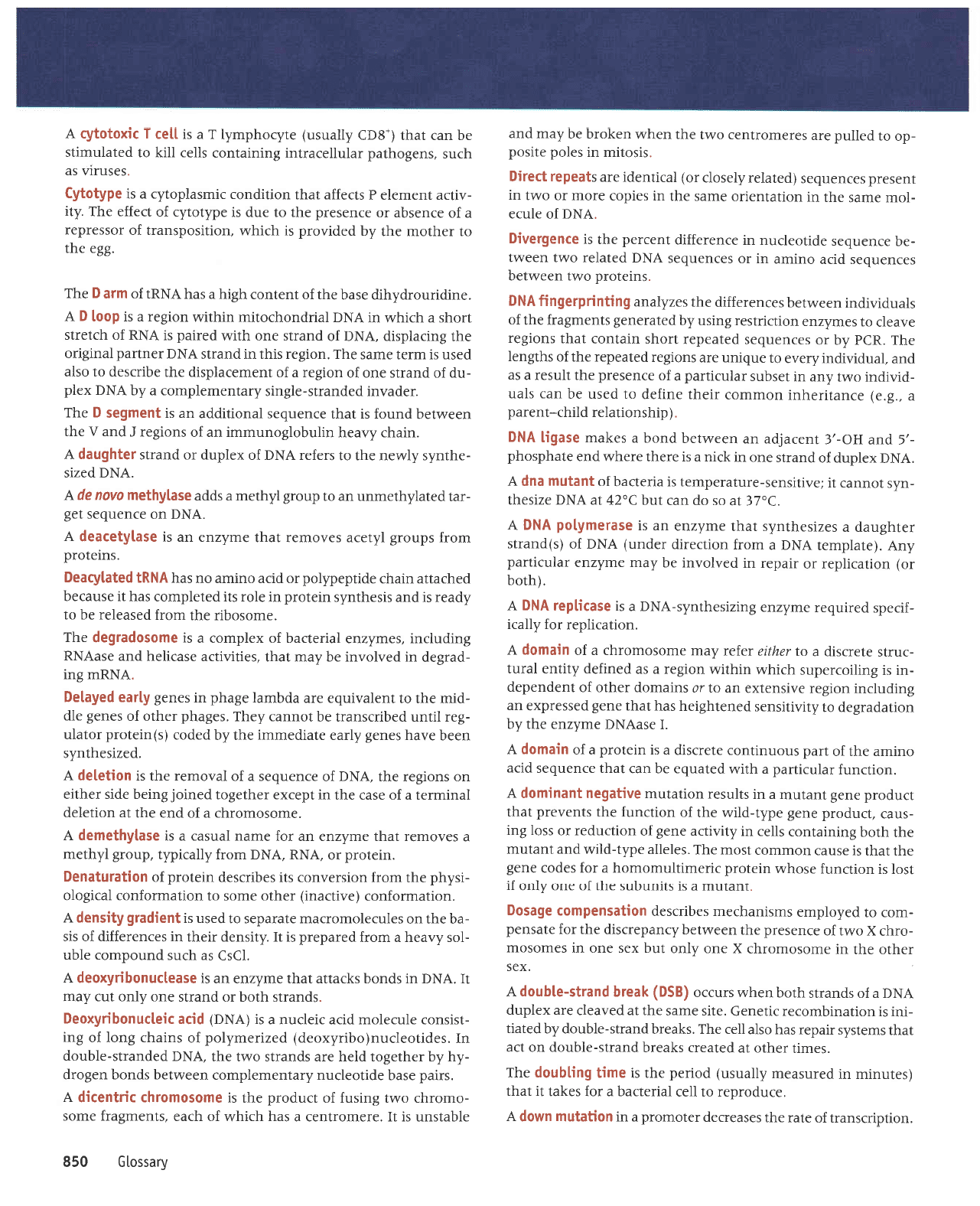
'uolldllJsuerl
Jo
eler eqt
sasearJep ralourord
p
ur
UOgelnU ul
Op
y
'a)npordrr
ol
IIaJ Ietrrlf,eq
e JoJ sa{p1
1r ]eq]
(salnutu
ur
parnspaur.{1ensn)
porrad
eqt
sl
aurg 6ugqnop
aq1
'saurl
raqlo
le
pelparJ
s>leeJq puprls-elqnop
uo
De
leql
srualszi.s rredar
seq
osle
IIaJ
eqJ
's>learq
puerls-JIqnop
,lq palerl
-rur
sr uorlpurquro)ar
)rleua9
'elrs
aures aql
lp
pa^eJlr
are xaldnp
VNC
p
Io
spuerls qtoq
ueqM
srnrf,o
(956)
learq
pue.4s-olqnop
V
.XAS
Ieqlo
aql ur eurosoruorql
x
Juo ,l1uo
1nq
xJS
euo ur saruosoru
-orqJ
x
o1vrl
Jo
aruasard
aqt
ueaMlaq,buedaDsrp
aqt roJ
alesued
-ruol
ot
pa,{oldrua
srusrupq)eur
seqrrf,sep
uoJlpsueduo: abesoq
'luetntu
p
sr slrunqns
aqt
Jo
Juo ,{1uo
.;r
lsol
sI uollf,unJ
asoqm
ulelord
JrJerurllnruouoq
p
ro;
sapor aua8
eqr
rpqt
sl asne)
uouruoJ
tsoru
eql'salrlle
ad,{t-p1ltn
pue
tuptnur
aql
qloq
Eurureluor
sllal
ur,hr,rrpe
auaS;o uorlrnpar
ro ssol 8ur
-snpJ
'lJnpord
aua8
adLl-ppu
eql
Jo
uorltunJ
aqt slue^J_rd
teqt
nnpord
aua8
luetnru
e ur sllnser
uortelnur
alllp6eu
lueuluop
V
'uorl)unJ
relnrrlred
e
qtrM
palenba
aq ue)
leql
aruanbas poe
ourrup
aql
yo
ued
snonurtuo)
eter)slp
e sr uralord
e
Jo
ureuop
V
'l
rspVNC
au{zuo
aqt
,(q
uorleper8ap
o1 ,i.tr.Lrlrsuas pauatq8raq
spq
leql
aua8
passardxa
ue
Surpnpur
uor8ar
alrsuelxo
ue ol ro
sureruop JJqlo
Jo
luapuadap
-ur
sr
8urlrorradns qrrq.tr
urqlrm
uor8ar
p
sp
peurJap
.il1r1ua
1ern1
-)nJls
alerJsrp
e ol Dtljtd
ra;ar z(eu
JtuosoruorqJ
p
Jo
uJeuop
V
'
uorlerrJdar
ro.1 r{11err
-;oads
parrnbar
aru{zua
Surzrsaqlu,{.s-VNC
p
sl
aseJlldol
VNO
V
'(qroq
ro)
uotlerlldar
ro rredar
ur
pallolur
aq ,{eru
aur,{zua
relnrrued
.,iuy
'(a1e1drual
VNe
e ruorJ
uort)arrp rapun)
VNC
Jo
(s)puerls
ralq8nep
e sazrsaqlu.{.s
teql
aru.{zua
ue sr
aserau/[1od
VNO
V
')"L€
7e
os op
ueJ
lnq
)"2?
le
VNCI
azrseql
-u.ds
louuer
u
lelrlrsues-Jrnleraduel
sr
prreDeq
Jo luP1nu
eup
V
'ygq
xaldnp
Jo
puprls
auo ur
{)ru
p
sr
areqt araqM pue
aleqdsoqd
-,E
pue
HO-,€
lue)plpe
ue
ueaMtaq
O:oO
n
sa{eu
asp6S
VNg_
'
(orqsuorlelar
PIIQr-tuareo
e
''E'a)
a)uetrraqur
uoruruoJ
Jraqt
aurJap ot
pasn
eq up) slen
-pl^Ipul
o,ul
,{ue uI
tesqns
relnrrlred
e;o aruasard
aqt
tlnsJr
e se
puP
'lpnpr^Ipur
z{ra,ra
ot
anbrun
are suor8ar
paleadar
aqf
;o
sqf8ual
eql
'U)d
zlq
ro saruanbas
paleadar
uoqs
ureluor
1eq1
suor8ar
aleal) ol
sarul.zua
uorprrlsar
3ursn,(q paleraua8
sluaru8eJJ
eql
Jo
slenpr^rpur
uaeMlaq
seJuareJlrp
aql saz,{1eue
6upuprdra6u$
vN0
'suratord
o,trl uaeMlJq
saruanbas prJp
ourure
ur ro
saJuenbas
y51q
palelar
oMl ueeMl
-aq
aruanbas
aprloepnu
ur
a)uareJlrp
luarrad
aqr s1
aruafuanlg
'vNC
Io
alnre
-loru
aurps aql
ur uorlpluerro
atups
aql ur sardor
aJoru Jo
o,ltl ur
tuasard
saluanbes
(pa1e1ar.d1asop
ro)
lerrluapr
are
sleedal
patlq
'srsotrru
ur
salod alrsod
-do
o1
pa11nd
eJp sararuortuar
o.trl
eqt uequ
ua>lorq
aq Leru
pue
^rPssolg
0gg
alqplsun sl
tI
'aleruorlueJ
e spq
qrlqu
Jo
q)ea
'sluaru8er;
auros
-orrrorqf,
o,u1 Sursny;o
nnpord
eqt sl
oruosoruotql lFluotlp
V
'srred
aseq eprloalJnu,{reluaualdruoJ
uaeuleq spuoq
uaSorp
-r(q
,tq raqla8ot plaq
eJe spuerts o,lr1 aql
'vNC
pepupnls-alqnop
uI
'saprloepnu(oqrr,{xoap)
pazrrau,{1od
1o
sureqr
Euol
;o
3ur
-lsrsuor
elnralou prJp
JrelJnu e sl
(VNq)
plle
llallnuoqu/[xoa6
'spuerls
qloq
ro pupJts
auo ,{1uo
1nr
,{eu-r
1I
'VNC
uI spuoq s>pelle
teql
aurlzua ue sI
Oseallnuoqp/lxOap
y
'lfs)
se
qrns
punoduor
alqn
-1os
.,heaq
p
ruoJJ
paredard
s1
t1
z(trsuap
rreql ur sarueJeJlrp
Jo
srs
-eq
aql uo salnJelouor)eur
aleredas ot
pasn
sr
lualper6
flrsuap
V
'uorlpruJoJuor
(anrpeur)
raqlo eruos ol
uorleruJoJuor
letr8olo
-ts.{qd
eql ruorJ uorsraluo) sll
saqlrJsap uralord
Jo
uoJletnlpuag
'uratord
ro
'VNU 'vN(
ruorJ.dletrd,fu
'dnorE
1u(qtaru
e saloruer
teqt
aru.dzua
up roJ eureu
Ipnspt
p
sr
aselfqleuap
V
'aurosouorqr
p
Jo
pua
aql
le
uouelep
Ieurruret
p
Jo
ese) aql u1
ldarxa
raqlaSol peuroI
Suraq
aprs raqlre
uo
suor8ar eql
'vNe
yo
aruanbas
p
Jo lelourer
aqt
sr
uollalap
v
'pazrsaqluAs
uaeq elpq saua8 Lyrea
Jlelpeuur aqf ,{q
papor (s)uralord
ro1e1n
-8ar
Irtun
peqrrJsuerl
aq
louup)
[aq1
'sa8eqd
rer{to
Jo
saua8 a1p
-pru
aql o1
lualezrrnba
rJe
ppqruel
a8eqd ur saua8
/t1ree
pe/iplaq
'vNuru
dur
-per8ap
ur
pello^ur
aq
Leu
leql
'salll^rtrp
ase)rlaq
pup
esevN5
Surpnpur
'saru,{zua
lerreDpq
;o
xaldruot
p
sr
oluosoper6ap
aql
'aruosoqrr
aql luorJ pasealar
aq o1
,{pear
sr
pue
srsaqtuds uralord
ur alor slr
pataldurol
seq
lr
esneJeq
paqJple
urcqr
epudad,{.1od ro
poe
ou1rup ou seq
VNUI
pelelfleaq-
'suraloro
uror; sdnor8
1.{1are
sa,rorueJ
lpql
aru.{.zua
ue sr
asel/l1a]pep
V
'VN61
uo aruanbas
ta8
-re1
pa1e1,{.q1aruun
ue ot dnor8
1,{qtJrrr
e
sppe
eselfiqleu
oAou apy
'vNC
pazrs
-aqtu,{s
.d1,t.au
aql ot sraler
VN61
Jo
xaldnp ro puerls
Jalq6nep
V
'ureqr
z(,reaq
urpqolSounurrur
up
1o
suorEar
f
pup
A
aql
uaaMlaq
punoJ
sI
leql
aruanbas
Ieuorlrppe
ue sr
lueu6as
0
er{J
'rapelur
papuerts-afurs
zheluarualdruor
e ,{q
y51q
xald
-np
Jo
puerts
euo
;o
uorSar
p
Jo
tuerueJeldsrp
aqr aqrrrsep
ol osle
pesn
sr rurrt
aurPs aq1
'uor8ar
slql ul
puerls
vN(
rauued
leurErro
aq1 Surreldsrp
'VNC
Io
puerls
euo
qllM parred
sl
vNu
Jo
qJlJrls
lroqs
p
q)lq,lr
ul
vNA
IprrpuoqJotrur
urqlru uor8ar
e sl
dool
0
V
'aurprrnorp.dqtp
aspq aqt
Jo
tueluor
q8rq
e
seq
VNU1
Io
lrt.te
0
aqJ
.BBa
aqr
ol reqlolu
aqt ulq
paprrrord
sr
qJrqu
'uorlrsodsuert
;o
rossardar
p
Jo
aJuesqp ro aruasard
aql ol anp
sr ad,{.lolb
Jo
DeJJo
aql
'^11
-Allrp
tuauele
d
spa;Jp
tpql
uorlrpuor rnuseldo/r
e sr
gdrqql/[1
.SESNJIA
SP
qrns
'suaSoqled
-re1n11alerlur
SururetuoJ
slla)
IIr>l
01
patelnurls
eq upr
rpql
(.8e)
,{1ensn)
a{roqdru,ll
J
e sr
lle]
I
rgololfr
y
